Chess Notes
Edward Winter
When contacting us by e-mail, correspondents are asked to include their name and full postal address and, when providing information, to quote exact book and magazine sources. The word ‘chess’ needs to appear in the subject-line or in the message itself.
| First column | << previous | Archives [167] | next >> | Current column |
10851. Capablanca v Snowden
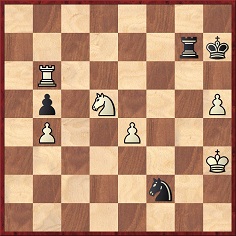
White to move
Capablanca played 47 Kh4 and eventually won after 47...Nxe4 48 h6.
The game has been submitted by John Hilbert (Amherst, NY, New York) on the basis of notes which he took many years ago, and we are also grateful to Eduardo Bauzá Mercére (New York, NY, USA) for providing the relevant newspaper columns.
Firstly, the score of the game, which was played in a 17-board simultaneous exhibition at the Franklin Chess Club:
José Raúl Capablanca – W.H. Snowden
Philadelphia, 19 November 1915
Bird’s Opening
1 f4 d6 2 e4 Nc6 3 Nf3 e5 4 Bb5 Nf6 5 Nc3 Bg4 6 d3 Be7 7 O-O O-O 8 Bxc6 bxc6 9 h3 Bxf3 10 Qxf3 h6 11 fxe5 dxe5 12 Kh1 Qd7 13 Nd1 Nh7 14 Ne3 f6 15 Nf5 Kh8 16 Qg4 Bd6 17 Nxh6 Qxg4 18 Nxg4 Bc5 19 Be3 Bb6 20 a4 a5 21 Bxb6 cxb6 22 Ne3 Ng5 23 Nc4 Rab8 24 c3 Ne6 25 b4 axb4 26 cxb4 b5 27 axb5 cxb5 28 Ne3 Nd4 29 Nd5 Rf7 30 Ra3 Ne2 31 Rfa1 Rfb7 32 g4 Kh7 33 Kg2 Kg6 34 h4 Kf7 35 Ra7 Nd4 36 Rxb7+ Rxb7 37 g5 Nc2 38 Rf1 Kg6 39 gxf6 gxf6 40 Rxf6+ Kh5 41 Kh3 Ne1 42 Rf5+ Kg6 43 Rxe5 Nxd3 44 Re6+ Kh7 45 h5 Rg7 46 Rb6 Nf2+ 47 Kh4 Nxe4 48 h6 and wins.
Source: the chess column of David A. Mitchell in the Philadelphia Public Ledger, 15 December 1918, page 18:

A report on the exhibition had appeared on page 6 of the Philadelphia Inquirer, 21 November 1915:
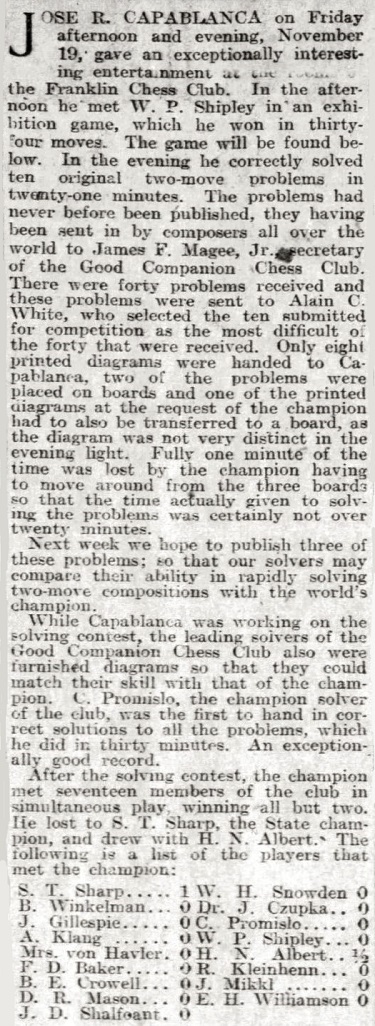
10852. I. Gunsberg v T.H. Moore
From page 2 of the 27 October 1894 edition of the Nottinghamshire Guardian:
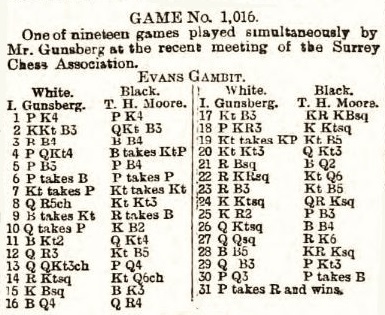
1 e4 e5 2 Nf3 Nc6 3 Bc4 Bc5 4 b4 Bxb4 5 c3
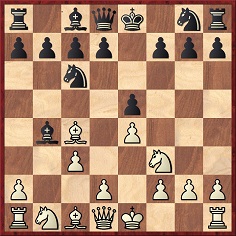
5...f5 6 cxb4 fxe4 7 Nxe5 Nxe5 8 Qh5+ Ng6 9 Bxg8 Rxg8 10 Qxh7 Kf7 11 Bb2 Qg5 12 Qh3 Nf4 13 Qb3+ d5 14 Rg1 Nd3+ 15 Kf1 Be6 16 Bd4 Qh5 17 Nc3 Rgf8 18 h3 Kg8 19 Nxe4 Nf4 20 Ng3 Qg6 21 Rc1 Bd7 22 Rh1 Nd3 23 Rc3 Nf4 24 Kg1 Rae8 25 Kh2 c6 26 Qb1 Bf5 27 Qd1 Re4
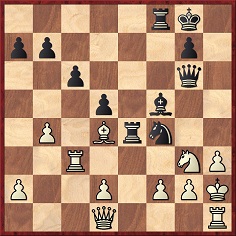
28 Bc5 Rfe8 29 Qf3 b6 30 d3 bxc5 31 dxe4 and wins.
The display took place in London on 6 October 1894 (BCM, November 1894, page 462).
As mentioned in The Evans Gambit, there was an article about 5...f5 on pages 373-374 of the November 1915 BCM. The move was played by Blackburne against ‘C. and W.’ in Hastings in 1894 (page 180 of P. Anderson Graham’s work on Blackburne) and, as mentioned in that book, was analysed by Oskar Cordel. See page 76 of his treatise Führer durch die Schachtheorie (Berlin, 1888), as well as a feature on pages 56-58 of Brüderschaft, 18 February 1888.
10853. Blackburne in Newcastle
On the subject of Blackburne and the Evans Gambit, below is a game from pages 44-45 of the January 1895 BCM:
Joseph Henry Blackburne – J.W. Robson
Newcastle, 14 November 1894
Evans Gambit Accepted
1 e4 e5 2 Nf3 Nc6 3 Bc4 Bc5 4 b4 Bxb4 5 c3 Ba5 6 d4 exd4 7 O-O dxc3 8 e5 d5 9 exd6 Qxd6 10 Qb3 Qg6 11 Ba3 Nge7 12 Nxc3 O-O 13 Rfe1 Re8 14 Ne5 Nxe5 15 Rxe5 Bh3 16 g3 Bxc3 17 Qxc3 Nc6 18 Rxe8+ Rxe8 19 Rd1 Qe4 20 Bd5
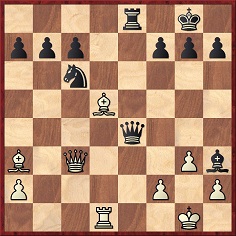
20...Nd4 21 Bxe4 Ne2+ 22 Kh1 Nxc3 23 Rc1 Rxe4 24 f3 Re3 25 White resigns.
The BCM gave the game with notes by G.C. Heywood in the Newcastle Weekly Chronicle. We do not have electronic access to the relevant edition of that newspaper, but page 61 of the R.C. Griffith scrapbook (C.N. 10811) has this unidentified cutting whose annotations match those in the BCM:
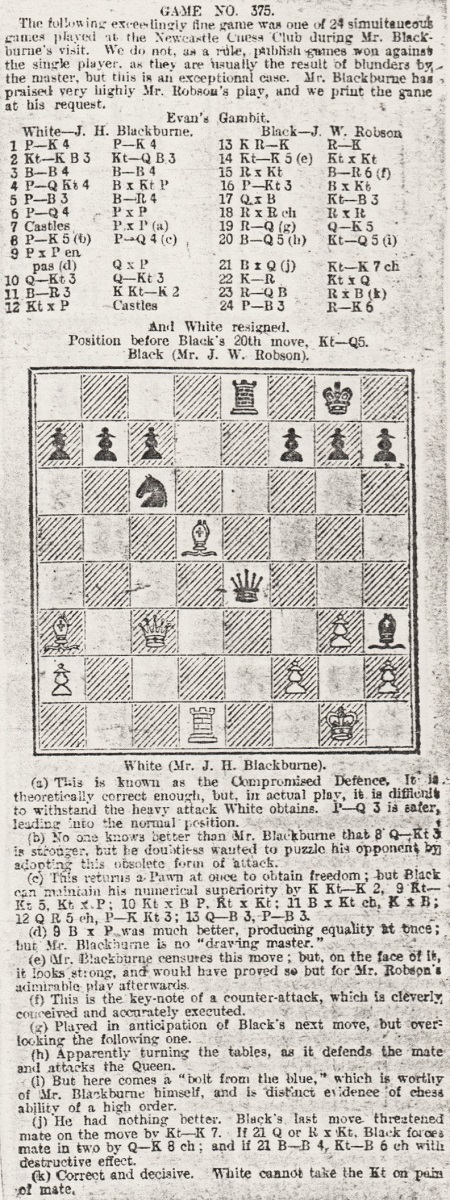
Page 496 of the December 1894 BCM gave the date of the 24-board display (+17 –2 =5) as 14 November 1894 and named two of the victors as J.W. Robson and G.H. Blunden. The latter’s win was published on page 2 of the Newcastle Courant, 1 December 1894: 1 e4 e6 2 d4 d5 3 Be3 c5 4 c3 cxd4 5 cxd4 Bb4+ 6 Nd2 Nf6 7 e5 Nfd7 8 f4 f6 9 Bd3 Nb6 10 Nf3 f5 11 O-O Bd7 12 Ng5 Be7 13 Ndf3 Nc6 14 Rc1 Nb4 15 Bb1 Nc4 16 Rxc4 dxc4 17 Re1 Nd5 18 Bd2 Qb6 19 Bc3 Nxf4 20 Kh1 h6 21 Nh3 Nxh3 22 gxh3 Bc6 23 Kg1 O-O-O 24 Nd2 Rxd4 25 Bxd4 Qxd4+ 26 Kf1 Bc5 27 Ne4 Qg1+ 28 Ke2 Qg2+ 29 Nf2 Qxf2 mate.
10854. J.H. Blackburne v H.W. Hawks (C.N. 8294)
Another simultaneous game played by J.H. Blackburne in Newcastle in November 1894 was given in C.N. 8294, from page 2 of the Newcastle Courant, 24 November 1894. It will be noted that the newspaper’s numbering of the moves was faulty:
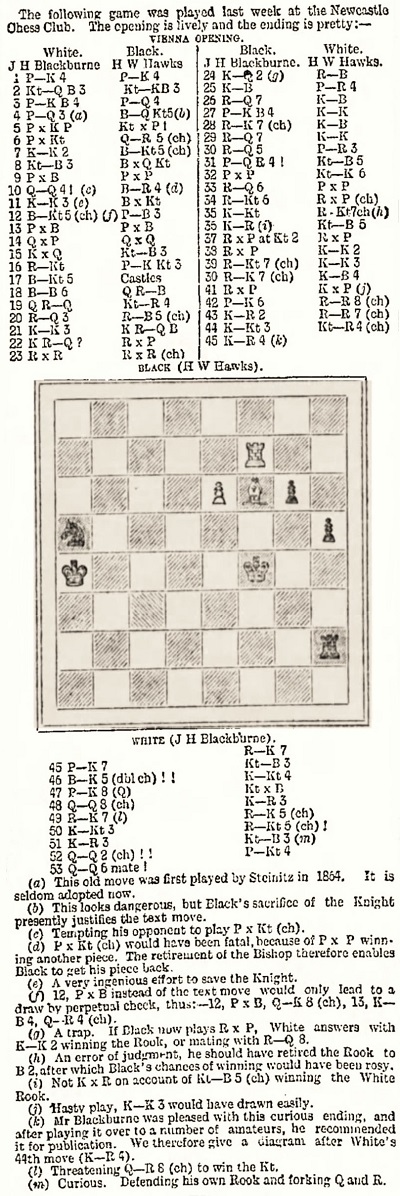
10855. Golombek
‘Dr Golombek’, ‘Sir Henry Golombek’ and ‘Sir Harry Golombek’ have been mentioned in C.N.s 3226, 3255 and 5674, and Geoff Chandler (Edinburgh) now adds a prominent specimen on page 605 of the October 1972 Chess Life & Review:
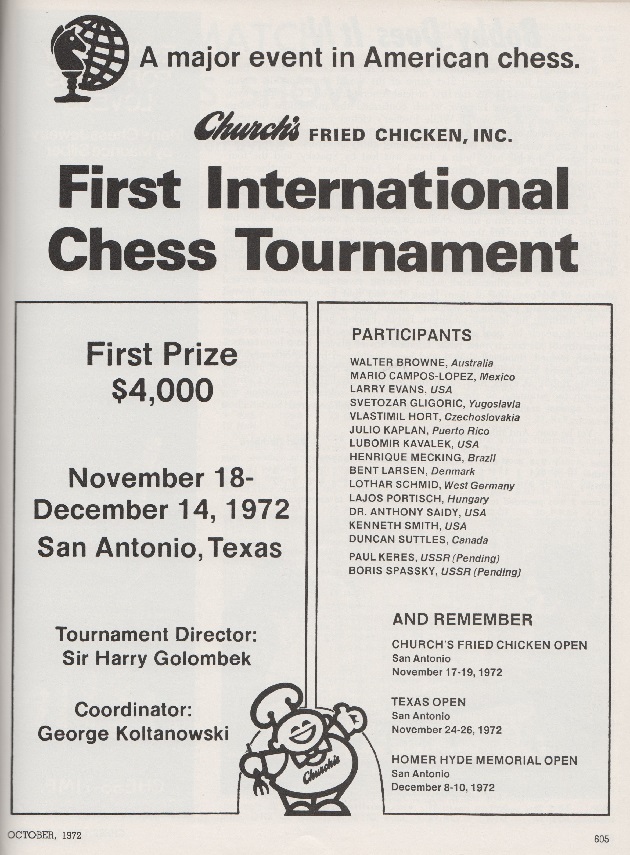
The announcement was repeated without correction on page 669 of the November 1972 Chess Life & Review. That latter issue (page 704) also had ‘Sir Harry Golombek’ in a feature about the San Antonio tournament.
‘Sir Harry Golombek’ is a mistake to be expected from Koltanowski; see, for instance, page 5 of Colle System (Coraopolis, 1984). Another example from the United States is the frontispiece of the book by Larry Evans and Ken Smith on the 1972 world championship match. That occurrence was criticized on the cover page iii of CHESS, June 1973, yet on the cover page iii of the previous month’s issue the magazine itself had referred to ‘Professor H.J.R. Murray’. For further instances of that error see The Chess Historian H.J.R. Murray.
10856. Interviews
‘Why is it that you have been so much more successful than other people?’
That question, actually put to a candidate for a FIDE post and published in a chess magazine, is an extreme example of a longstanding problem mentioned in Chess Thoughts: In proper journalism, the interviewer probes, politely but searchingly. In chess journalism, vacuous servility is the norm.
The word is interview, not intervertisement.
10857. The Rice Gambit (C.N.s 6857, 10781, 10789 & 10825)
Hans Renette (Bierbeek, Belgium) sends this column by Emanuel Lasker on page 10 of the New York Evening Post, 29 July 1908:

As shown in C.N. 6857, the text was reproduced on page 98 of Lasker’s Chess Magazine, September 1908.
10858. The
Lasker v Schlechter title match conditions
A further contribution from Mr Renette is the chess column on page 5 of the 23 December 1908 edition of the New York Evening Post:

This column is significant with regard to the controversy over the conditions for the 1910 Lasker v Schlechter world championship match and has been quoted, inter alia, on pages 162-163 of the April 1975 BCM.
Concerning the controversy, see the references in the Factfinder and, particularly, in C.N. 7109.
10859. Alekhine smoking story (C.N. 5169)
C.N. 5169 mentioned, but did not show, this report on page 374 of the December 1930 Wiener Schachzeitung:
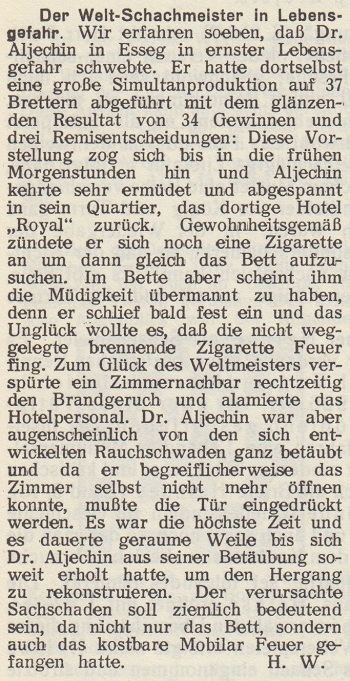
An addition from the Daily Herald (London), 30 December 1930, page 2:
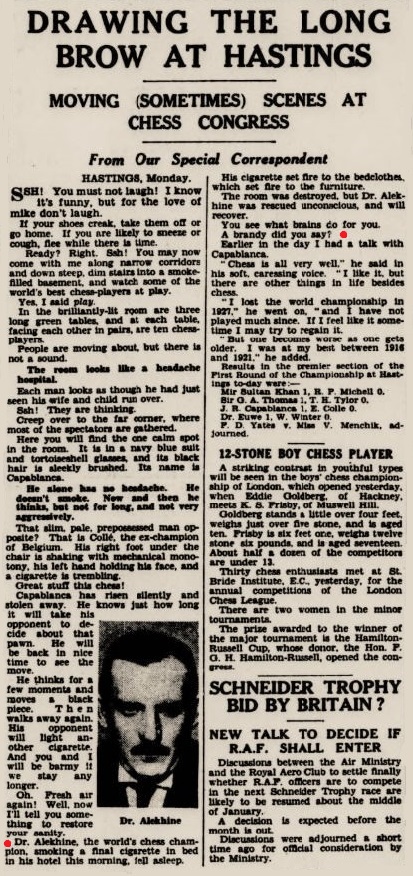
The report, headed ‘Monday’ (i.e. 29 December 1930), states, improbably, that the hotel fire occurred ‘this morning’. On that day, as shown by page 389 of the Skinner/Verhoeven book on Alekhine, the world champion was in Novi Sad, having previously been in Subotica. On 23 December 1930 he gave a simultaneous exhibition in Osijek, the city referred to in the Wiener Schachzeitung report (Esseg in German).
10860. Princess Tatiana Wiasemsky/Wiazemsky (C.N.s 7633 & 9229)
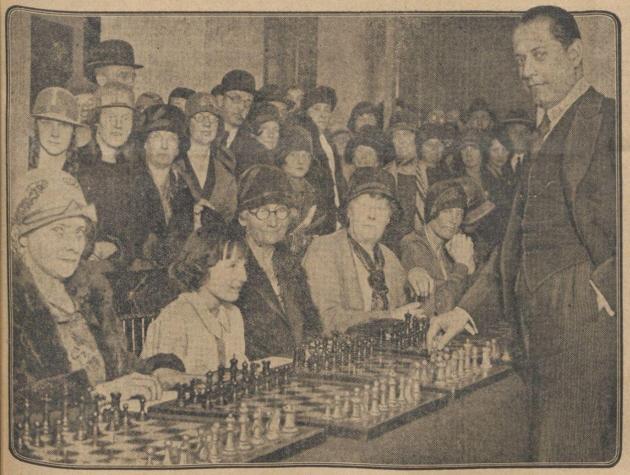

The above, from the 14 May 1929 edition of De Sumatra
Post (Medan), is one of a pair of photographs of
Princess Tatiana Wiasemsky/Wiazemsky in C.N. 7633.
A further picture, from page 9 of the Sheffield Daily Telegraph, 2 May 1929:
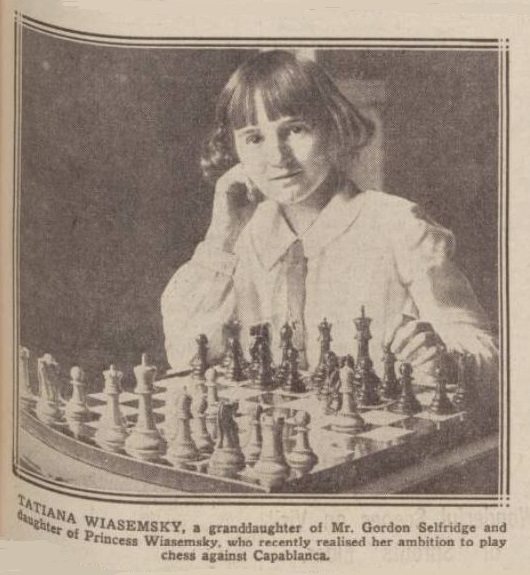
10861. Chess Personalia
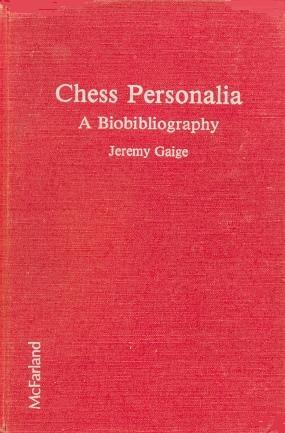
Chess Personalia A Biobibliography by Jeremy Gaige was published by McFarland & Company, Inc. in 1987, and a paperback reprint was issued in 2005. Gaige died in 2011.
The paperback edition corrected a large number of typographical errors in the Introduction but had no updating of the biobibliographical entries, even though Gaige had continued to add information to his archives, and notably in an 860-page revised, updated and expanded edition privately circulated in 1994.
Robert Franklin (Jefferson, NC, USA), the former President of McFarland whose title is now Founder and Editor-in-Chief, informs us that when the company issued the paperback it was unaware that an updated version existed:
‘We have never received a copy. We did not learn of its existence until years later. He did not have the legal right to publish the revision (because he had signed over to us, routinely, as with all McFarland authors, the rights to the book and the title, so it took us aback a bit when we learned). We did nothing about it and treated his widow with great care and respect after his death. We would certainly have considered a revised edition if he had approached us about it.’
Concerning C.N. 10831, on Tim Harding’s recent list of amendments to Chess Personalia, Mr Franklin writes:
‘The complaint is faulty that Tim Harding should have known the 1987 book had already had revisions “privately distributed” and therefore should not have gone to the trouble of offering amendments to same in his British Chess Literature to 1914 (McFarland, 2018). The crux of the matter is: Who has access to the 1994 “edition”? If the legal owner of the item (!) has never seen one, and a senior ranking, very sober-minded chess author is not aware of it, one begins to think that the corrections offered by Mr Harding are in fact useful at least to those who were not sent a copy in 1994.’
It is not a question of whether or not Tim Harding’s amendments are useful. The issue is the fairness and respect due to Jeremy Gaige. We already made the point in July 2017 (C.N. 10526):
Any chess writers tempted to boast – in book publicity material or in a Preface, for instance – that they have found corrections to Jeremy Gaige’s Chess Personalia (Jefferson, 1987) naturally need to check that the matters were not rectified by Gaige himself in his unpublished 1994 edition.
Throughout his life, Gaige circulated private editions of his works to researchers who might be able to assist him, and it is self-evident that he did not cease updating Chess Personalia after the book was published in 1987.
That leaves Mr Franklin’s comments about whether Harding should have known about the privately distributed edition. It has been referred to in C.N.s 2799 (posted in 2002 and reproduced on page 153 of our McFarland book Chess Facts and Fables), 3595, 4398, 4579, 4609, 4661 4836, 4982, 5112, 5115, 6975, 7054, 7774, 7854, 8677, 8831, 8945, 9034, 9086, 9135, 9193, 9612, 9668, 9680, 9727, 9773, 9845, 10120, 10156, 10357, 10526, 10680 and 10804.
10862. 1 d4 Nf6 2 Bg5
C.N. 8732 (see also The Trompowsky Opening) asked what is known about Bill Ruth’s use or advocacy of 1 d4 Nf6 2 Bg5 in the 1920s.
Eduardo Bauzá Mercére (New York, NY, USA) sends this telephone game played by Ruth (White) against I.S. Turover from page 6 of the Philadelphia Inquirer, 17 December 1922:
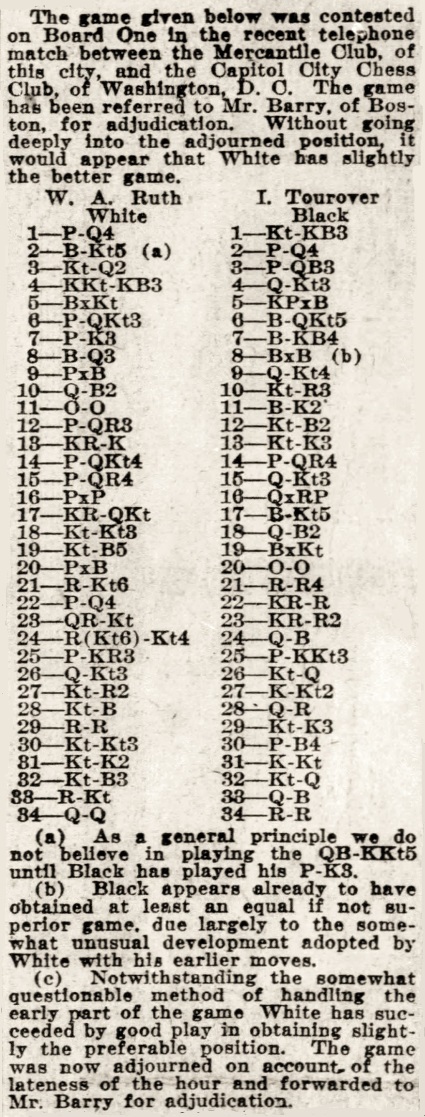
1 d4 Nf6 2 Bg5 d5 3 Nd2 c6 4 Ngf3 Qb6 5 Bxf6 exf6 6 b3 Bb4 7 e3 Bf5 8 Bd3 Bxd3 9 cxd3 Qb5 10 Qc2 Na6 11 O-O Be7 12 a3 Nc7 13 Rfe1 Ne6 14 b4 a5 15 a4 Qb6 16 bxa5 Qxa5 17 Reb1 Bb4 18 Nb3 Qc7 19 Nc5 Bxc5 20 dxc5 O-O 21 Rb6 Ra5 22 d4 Rfa8 23 Rab1 R8a7 24 R6b4 Qc8 25 h3 g6 26 Qb3 Nd8 27 Nh2 Kg7 28 Nf1 Qa8
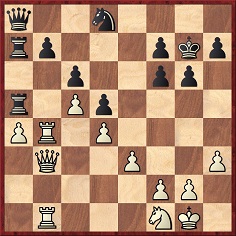
29 Ra1 Ne6 30 Ng3 f5 31 Ne2 Kg8 32 Nc3 Nd8 33 Rb1 Qc8 34 Qd1 Ra8. Submitted for adjudication.
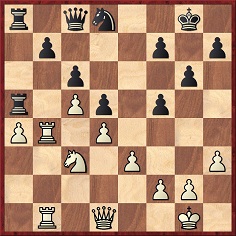
Page 6 of the 14 January 1923 edition reported that J.F. Barry had adjudicated the game as a draw.
10863. Dawid Janowsky
Macauley Peterson (Hamburg, Germany) asks about the birth-date of Dawid Janowsky, in view of queries about this recent statement in a ChessBase article by André Schulz:
‘According to the Gregorian calendar, which is used today, Janowski was born on June 7, 1868, in Wolkowysk, a Polish town which at that time was part of the Russian empire. But according to the Julian calendar, which at that time was still in use in Wolkowysk, Janowski was born on May 25.’
Firstly, we note that the ‘standard’ date given in chess literature is 25 May 1868, as exemplified by these extracts from page 7 of Voronkov and Plisetsky’s book on Janowsky (Moscow, 1987) and from page 1 of Ackermann’s monograph on him (Ludwigshafen, 2005):



The Russian text was a translation of a 1927 article by Alphonse Goetz; the first sentence in the footnote is a general remark that dates throughout the book, including those taken from Russian sources, are given in the new style. (That does not apply to the date 25 May 1868.) Concerning the Julian and Gregorian calendars, it may be wondered why the difference for that nineteenth-century date is given as 13 days and not 12. (See When Was Alekhine Born?) One would expect 25 May/6 June 1868.
Another question is what relevance the two calendars may or may not have in the context of Janowsky’s place of birth, given in various English-language sources as Volkoysk, Volkovysk, Walkowisk and Wolkowysk (Wołkowysk) and, in German sources, as Walkowijsk, Walkowisk and Waukawysk. On page 15 of the January 1956 Chess Review, Ossip Bernstein wrote that Janowsky was born ‘in the Polish-Jewish industrial city of Łódź, then still in Imperial Russia’.
Jeremy Gaige’s entry in the unpublished 1994 edition of Chess Personalia:
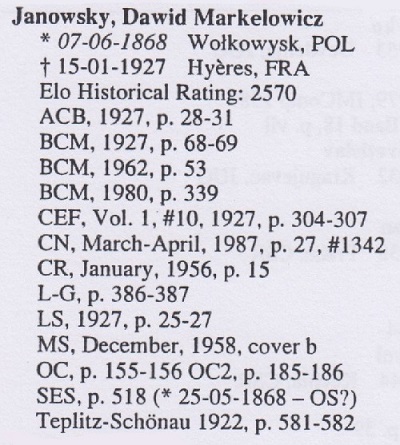
At the very least, we should like to build up a list of publications during Janowsky’s lifetime which specified an exact date and place of birth. No such information is given in the biographical note on him in the Hastings, 1895 tournament book (pages 355-356); page 581 of the Teplitz-Schönau, 1922 tournament book – another standard source for such information – stated: ‘geb. am 25. Mai 1868 in Walkowisk bei Grodno’. Page 216 of the November 1898 American Chess Magazine reported that ‘he was born in Russian Poland, 25 May 1868’, and the same date was in F.M. Teed’s ‘Chess Chronology’ on page 169 of the May 1903 issue of Checkmate. On page 307 of The Year-Book of Chess, 1912 edited by E.A. Michell (London, 1912) Janowsky’s entry in the ‘Chess Lovers’ Kalendar compiled by Miss Clara Millar’ had 28 May 1868.
In view of the dearth of primary sources, anyone given to Grübelsucht may be tempted to ask provocatively: how can it be stated for certain that even the year 1868 is correct? Where is the documentation?
Can readers assist us in taking the matter forward?
10864. Janowsky on Rubinstein
From Walter Penn Shipley’s chess column in the Philadelphia Inquirer, 6 February 1927 (page 3, puzzle section):
‘Janowsky had a very high opinion of Rubinstein and considered the Polish master one of the best living exponents of the chess openings. He told the editor of this column a few years ago when they met in New York that all the great masters at that time studied Rubinstein’s openings.’
10865. Norwegian chess history
Drawing attention to the Sjakkhistoriskforum, Morten Lilleøren (Oslo) informs us that three years ago a project was started to scan Norwegian chess periodicals and that about 99% of all such publications (approximately 60,000 pages) are now online.
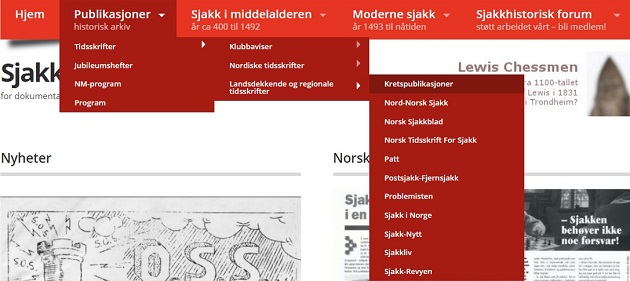
10866. Patreon
From Olimpiu G. Urcan (Singapore):
‘Earlier this month I launched a new initiative, a subscription-based digital column intended to offer quality material of interest to chess history enthusiasts, including photographs, audiovisual items, interviews, little-known games, analysis, essays and reviews.’

10867. A drawn game
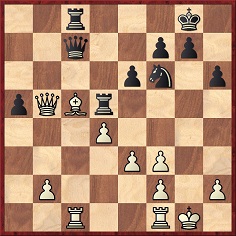
Black not to move
This position was discussed by Al Horowitz on pages 112-113 of How To Win in the Middle Game of Chess (New York, 1955), in the section about perpetual check:
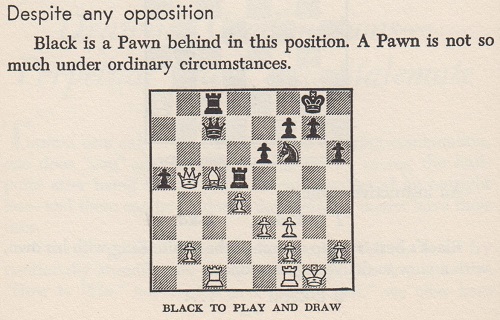
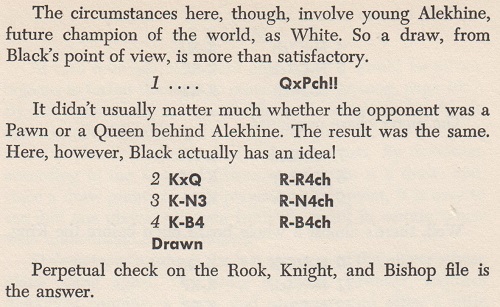
The text had previously appeared in an article by Horowitz on pages 87-89 of Chess Review, March 1954.
The play by ‘young Alekhine’ occurred when he was 30, against Teichmann at Carlsbad, 1923. The game was drawn, though later on and not by perpetual check; Teichmann could not sacrifice his queen in the diagrammed position because it was White’s move. Alekhine played 27 f4.
The situation after 26...Rd8-d5 was discussed on page 118 of the tournament book:
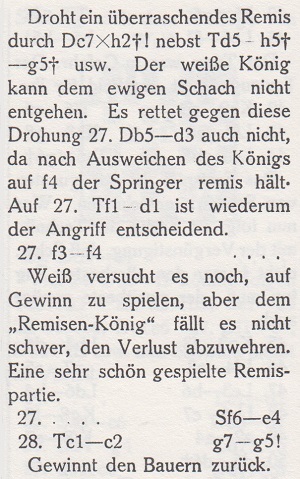
The complete game: 1 d4 d5 2 c4 e6 3 Nf3 Nf6 4 Nc3 Be7 5 Bg5 Nbd7 6 e3 O-O 7 Rc1 c6 8 Qc2 Re8 9 Bd3 h6 10 Bf4 dxc4 11 Bxc4 b5 12 Bd3 a6 13 a4 Bb7 14 O-O Rc8 15 Qb3 Qb6 16 Ne5 Red8 17 Ng6 Bf8 18 Nxf8 Nxf8 19 Ne4 Nxe4 20 Bxe4 Nd7 21 Bd6 Nf6 22 Bc5 Qc7 23 Bf3 a5 24 axb5 cxb5 25 Qxb5 Bxf3 26 gxf3 Rd5 27 f4 Ne4 28 Rc2 g5 29 f3 Nxc5 30 Rfc1 Rb8 31 Qe2 gxf4 32 dxc5 fxe3 33 Qxe3 Rg5+ 34 Kh1 Qc6 35 Rg1 Rxg1+ 36 Kxg1 Qd5 37 Rd2 Qf5 38 Rg2+ Kh7 39 Qe4 Qxe4 40 fxe4 Rc8 41 Rc2 Kg6 42 Kf2 Kf6 43 Ke3 Ke5 44 Kd3 f6 45 Rc4 f5 Drawn.
The opening was examined by Alekhine in his first Best Games book, in the annotations to his brilliancy-prize victory over Rubinstein in the first round of the same tournament.
10868. Register of visitors
Gerard Killoran (Ilkley, England) notes that a register of chess visitors to the Mechanics’ Institute in San Francisco is available online.
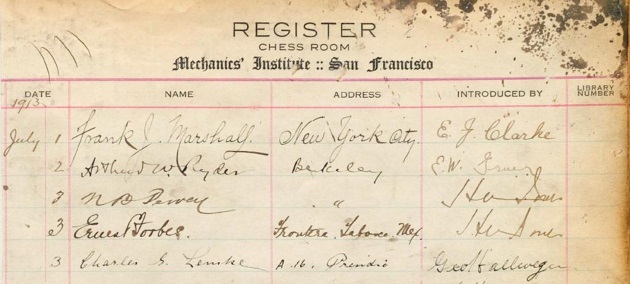
10869. Janowsky’s final days (C.N. 10776)
C.N. 10776 referred to the financial support given to Dawid Janowsky, shortly before his death in Hyères, by A.J. Maas.
On page 16 of the January 1956 Chess Review Ossip Bernstein described the oscillating relationship between Janowsky and Léonardus Nardus and concluded:
‘A few weeks before Janowsky’s death in 1927 he fell very ill. I cabled Nardus, who then lived in Tunisia, and he immediately sent a substantial amount of money for Janowsky.’
10870. Pillsbury odds game
In an article on pages 220-221 of Womanhood, 1903 Rhoda A. Bowles referred to Pillsbury’s exceptional memory:
‘Today Mr H.N.P. happened to call upon me, and I said, “I want you to give me the full score of such and such a game”, which he quickly located when I said that it was one at which he had conceded queen’s rook odds, and replied, “Oh, certainly; will you have it now?” I was writing, so replied, “Yes”. He simply called off move by move as quickly as I could write them, never even glancing at a chess board the while. Well, here it is, and I may add that it was played way back in 1892. This is only one example of all the games he has played – that is, of course, match games; for ask him at any moment for a similar account of any other game, and he will give it with the same ease.’
Rhoda A. Bowles then published the game with the notes given to her by Pillsbury:
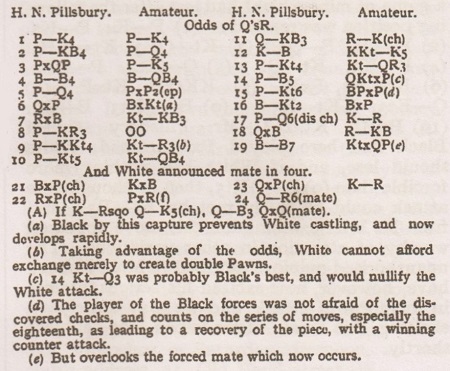
1 e4 e5 2 f4 d5 3 exd5 e4 4 Bc4 Bc5 5 d4 exd3 6 Qxd3 Bxg1 7 Rxg1 Nf6 8 h3 O-O 9 g4 Na6 10 g5 Nc5 11 Qf3 Re8+ 12 Kf1 Nfe4 13 b4 Na6 14 f5 Nxb4
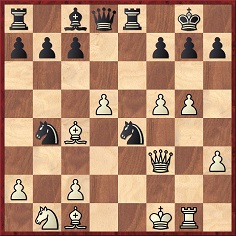
15 g6 fxg6 16 Bb2 Bxf5 17 d6+ Kh8
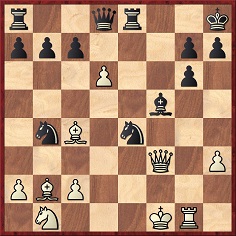
18 Qxf5 Rf8 19 Bf7 Nxd6. (Announced mate: 20 Bxg7+ Kxg7 21 Rxg6+ hxg6 22 Qxg6+ Kh8 23 Qh6 mate.)
As mentioned above, the Womanhood column dated the game 1892. Page 218 of Harry Nelson Pillsbury American Chess Champion by Jacques N. Pope (Ann Arbor, 1996) gave it as the only known score from a five-game rook-odds match won by Pillsbury against W. Southwick in Brooklyn, 1894. Pages 220-222 published seven of the ten games played in a second match (Brooklyn, 1894-95) between Pillsbury and Southwick at the same odds. The two matches were discussed on pages 7-9 of Pope’s fine book.
10871. Zollner v Heywood
Page 669 of the December 1976 Chess Life & Review had a question from a reader in Canada, Paul Sontag, in the ‘Larry Evans on Chess’ column:
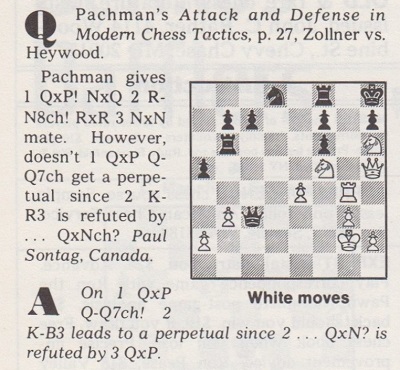
Pachman’s book gave no additional information about the occasion. Nor did page 100 of CHESS, 14 November 1938, where the full score was included in the seven-page feature on Louis Zollner referred to in C.N. 6607.
The game had been published on page 574 of the 3 November 1894 issue of the Illustrated London News, again with no date.
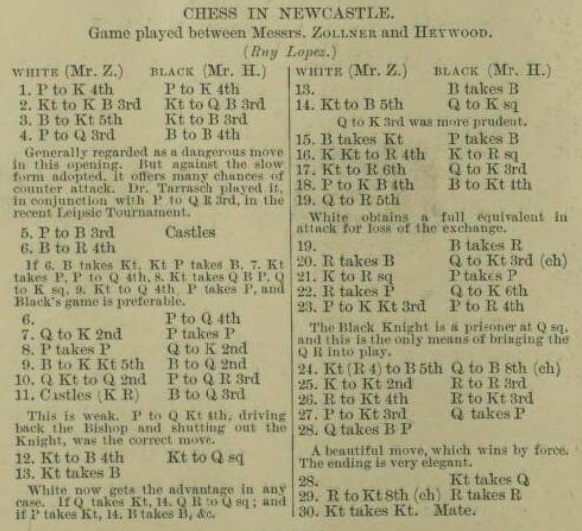
1 e4 e5 2 Nf3 Nc6 3 Bb5 Nf6 4 d3 Bc5 5 c3 O-O 6 Ba4 d5 7 Qe2 dxe4 8 dxe4 Qe7 9 Bg5 Bd7 10 Nbd2 a6 11 O-O Bd6 12 Nc4 Nd8 13 Nxd6 Bxa4 14 Nf5 Qe8 15 Bxf6 gxf6 16 N3h4 Kh8 17 Nh6 Qe6 18 f4 Bb5 19 Qh5 Bxf1 20 Rxf1 Qb6+ 21 Kh1 exf4 22 Rxf4 Qe3 23 g3 a5 24 N4f5 Qc1+ 25 Kg2 Ra6 26 Rg4 Rb6 27 b3 Qxc3
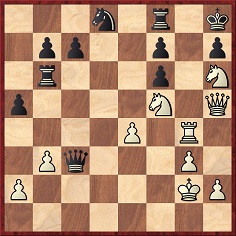
28 Qxf7 Nxf7 29 Rg8+ Rxg8 30 Nxf7 mate.
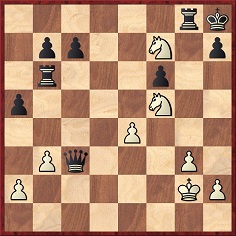
A computer-check indicates that a number of inferior moves were played on both sides.
George Cann Heywood died on 8 March 1895, aged 41. The photograph below is the frontispiece to the December 1893 BCM, accompanying the feature on him published on pages 507-512.
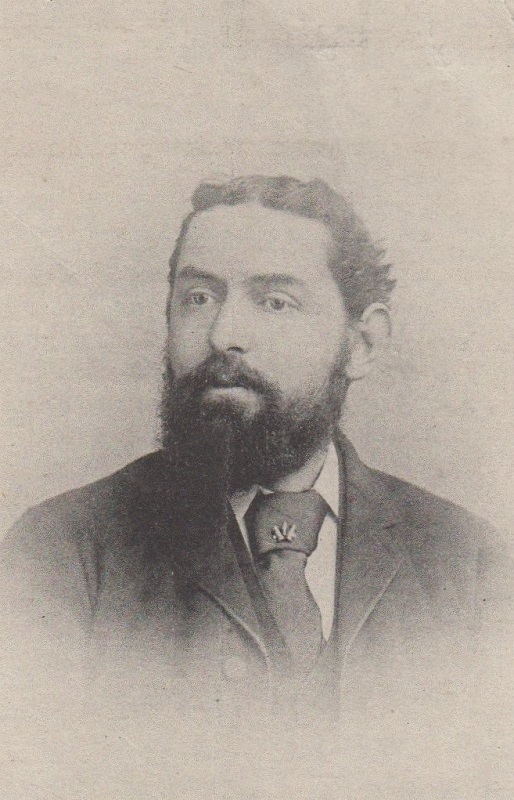
On pages 23-24 of the autumn 1996 Kingpin (see too pages 34-35 of Kings, Commoners and Knaves) we wrote about a composition of Heywood’s which is relevant to the famous Saavedra study.
10872. Further games by George C. Heywood
Seven games won by G.C. Heywood are taken from late-nineteenth-century chess columns with, unfortunately, scant details as to when and where most of them were played.
Heywood v Blackman:
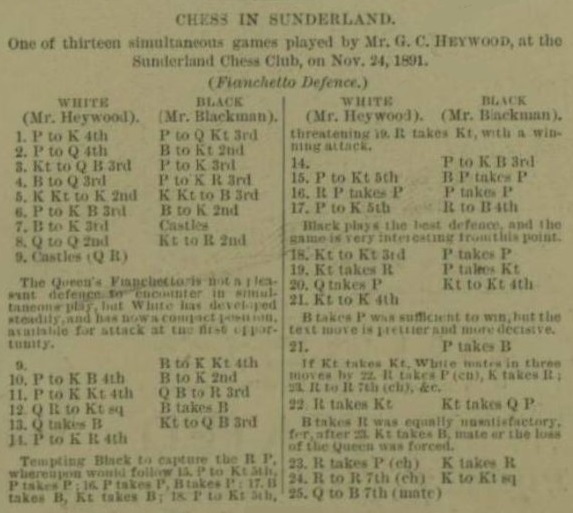
Supplement to the Illustrated London News, 23 January 1892, page 7
1 e4 b6 2 d4 Bb7 3 Nc3 e6 4 Bd3 h6 5 Nge2 Nf6 6 f3 Be7 7 Be3 O-O 8 Qd2 Nh7 9 O-O-O Bg5 10 f4 Be7 11 g4 Ba6 12 Rdg1 Bxd3 13 Qxd3 Nc6
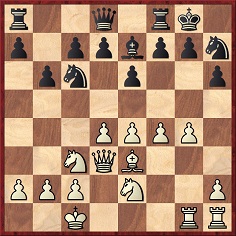
14 h4 f6 15 g5 hxg5 16 hxg5 fxg5 17 e5 Rf5 18 Ng3 gxf4 19 Nxf5 exf5 20 Qxf5 Ng5
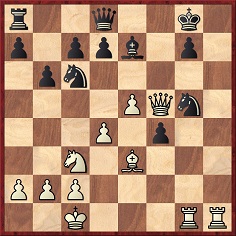
21 Ne4 fxe3 22 Rxg5 Nxd4 23 Rxg7+ Kxg7 24 Rh7+ Kg8 25 Qf7 mate.
Heywood v Twells:
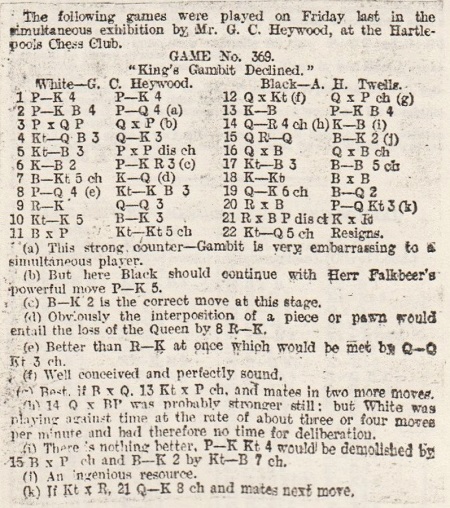
Unidentified cutting on
page 55 of the R.C. Griffith scrapbook (C.N. 10811)
Probably from the Newcastle Weekly Chronicle, circa
October 1894
1 e4 e5 2 f4 d5 3 exd5 Qxd5 4 Nc3 Qe6 5 Nf3 exf4+ 6 Kf2 h6 7 Bb5+ Kd8 8 d4 Nf6 9 Re1 Qd6 10 Ne5 Be6 11 Bxf4 Ng4+
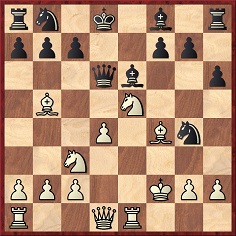
12 Qxg4 Qxd4+ 13 Kf1 f5 14 Qh4+ (14 Bg5+) 14...Kc8 15 Rad1 Be7 16 Qxe7 Qxf4+ 17 Nf3 Bc4+ 18 Kg1 Bxb5 19 Qe6+ Bd7
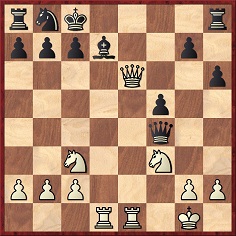
20 Rxd7 b6 21 Rxc7+ Kxc7 22 Nd5+ Resigns.
Heywood v Dunipace
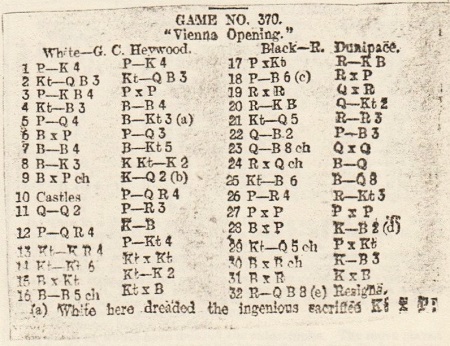
Incomplete unidentified
cutting on page 56 of the R.C. Griffith scrapbook (C.N.
10811)
Probably from the Newcastle Weekly Chronicle, circa
October 1894 (see Heywood v Twells)
1 e4 e5 2 Nc3 Nc6 3 f4 exf4 4 Nf3 Bc5 5 d4 Bb6 6 Bxf4 d6 7 Bc4 Bg4 8 Be3 Nge7 9 Bxf7+ Kd7 10 O-O a5 11 Qd2 h6 12 a4 Kc8 13 Nh4 g5 14 Ng6 Nxg6 15 Bxg6 Ne7 16 Bf5+ Nxf5 17 exf5 Rf8 18 f6 Rxf6 19 Rxf6 Qxf6 20 Rf1 Qg7 21 Nd5 Ra6 22 Qf2 c6 23 Qf8+ Qxf8 24 Rxf8+ Bd8 25 Nf6 Bd1 26 h4 Rb6 27 hxg5 hxg5 28 Bxg5 Kc7
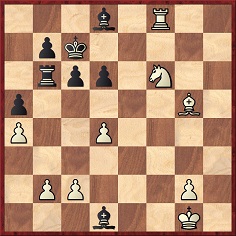
29 Nd5+ cxd5 30 Bxd8+ Kc6 31 Bxb6 Kxb6 32 Rc8 Resigns.
Zollner v Heywood:
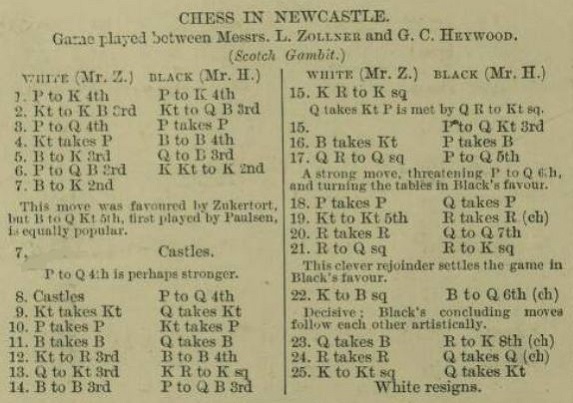
Illustrated London News, 24 November 1894, page 654
1 e4 e5 2 Nf3 Nc6 3 d4 exd4 4 Nxd4 Bc5 5 Be3 Qf6 6 c3 Nge7 7 Be2 O-O 8 O-O d5 9 Nxc6 Qxc6 10 exd5 Nxd5 11 Bxc5 Qxc5 12 Na3 Bf5 13 Qb3 Rfe8 14 Bf3 c6 15 Rfe1 b6 16 Bxd5 cxd5 17 Rad1
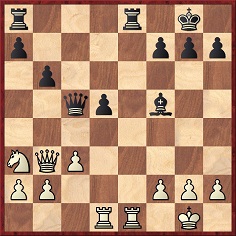
17...d4 18 cxd4 Qxd4 19 Nb5 Rxe1+ 20 Rxe1 Qd2 21 Rd1
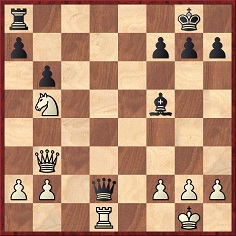
21...Re8 22 Kf1 Bd3+ 23 Qxd3 Re1+ 24 Rxe1 Qxd3+ 25 Kg1 Qxb5 26 White resigns.
Bang v Heywood; Heywood v Bell:
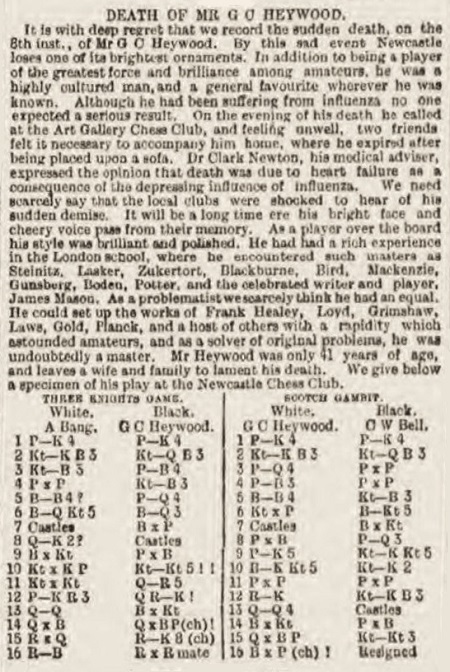
Newcastle Courant, 16 March 1895, page 2
1 e4 e5 2 Nf3 Nc6 3 Nc3 f5 4 exf5 Nf6 5 Bc4 d5 6 Bb5 Bd6 7 O-O Bxf5 8 Qe2 O-O 9 Bxc6 bxc6 10 Nxe5
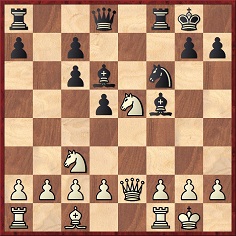
10...Ng4 11 Nxg4 Qh4 12 h3 Rae8 13 Qd1 Bxg4 14 Qxg4
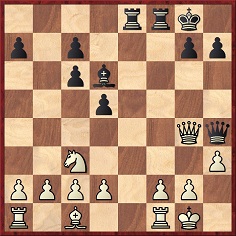
14...Qxf2+ 15 Rxf2 Re1+ 16 Rf1 ‘RxR mate’.
1 e4 e5 2 Nf3 Nc6 3 d4 exd4 4 c3 dxc3 5 Bc4 Nf6 6 Nxc3 Bb4 7 O-O Bxc3 8 bxc3 d6 9 e5 Ng4 10 Bg5 Ne7 11 exd6 cxd6 12 Re1 Nf6 13 Qd4 O-O 14 Bxf6 gxf6 15 Qxf6 Ng6
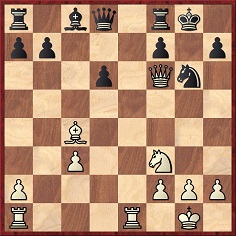
16 Bxf7+ Resigns.
J.B. v Heywood:
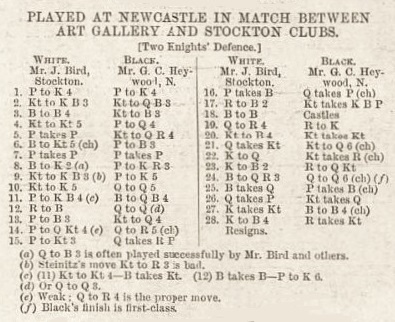
Illustrated Sporting and Dramatic News, 30 March 1895, page 136
When this game was published on page 512 of the December 1893 BCM White was named as J. Birks and an exact occasion was specified: ‘played at the Art Gallery, Newcastle, 21 January 1893, in the match between the Art Gallery and Stockton Chess Clubs.’
1 e4 e5 2 Nf3 Nc6 3 Bc4 Nf6 4 Ng5 d5 5 exd5 Na5 6 Bb5+ c6 7 dxc6 bxc6 8 Be2 h6 9 Nf3 e4 10 Ne5 Qd4 11 f4 Bc5 12 Rf1 Qd8 13 c3 Nd5 14 b4
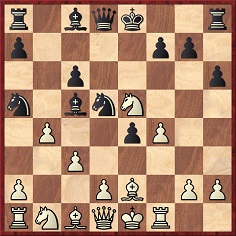
14...Qh4+ 15 g3 Qxh2 16 bxc5 Qxg3+ 17 Rf2 Nxf4 18 Bf1 O-O 19 Qa4 Re8 20 Nc4 Nxc4 21 Qxc4 Nd3+ 22 Kd1 Nxf2+ 23 Kc2 Rb8 24 Ba3
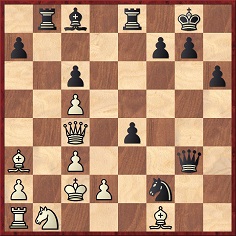
24...Qd3+ 25 Bxd3 exd3+ 26 Qxd3 Nxd3 27 Kxd3 Bf5+ 28 Kc4 Rxb1 29 White resigns.
10873. Obituary of G.C. Heywood
From page 8 of the Devon and Exeter Daily Gazette, 12 March 1895:

The reference to Mark Cann is a reminder of G.C. Heywood’s full name as given in the 1994 edition of Jeremy Gaige’s Chess Personalia:
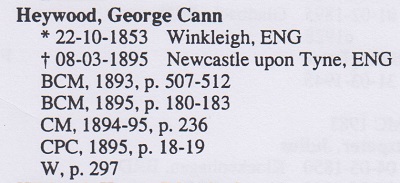
The spelling ‘Cann’ is confirmed by the Family Search website.
The 1987 edition of Chess Personalia had only ‘George C. Heywood’, and that was amended by Tim Harding on page 351 of British Chess Literature to 1914 (see C.N. 10831) to ‘George Carm Heywood’. ‘Carm’ was also the spelling used by Harding elsewhere in that book, and in his volumes on Victorian chessplayers and on Blackburne, but it is unclear why.
10874. Games played by H.J.R. Murray
From Olimpiu G. Urcan (Singapore):
‘The Bodleian Library, Oxford holds the H.J.R. Murray Papers (MSS H.J. Murray 1-168), donated to the library in 1955, the year of Murray’s death. This valuable archival material includes a document by Murray which gives details of his chessplaying activities (MS H.J. Murray 73, folios 210-292). It comprises a five-page introduction by Murray and 95 of his games, played between 1893 and 1937. Most were against club-level amateurs, but he also had encounters with Blackburne and Atkins.’
Our correspondent plans to present a large selection of the games on his Patreon webpage (C.N. 10866) but has given us the two above-mentioned scores:
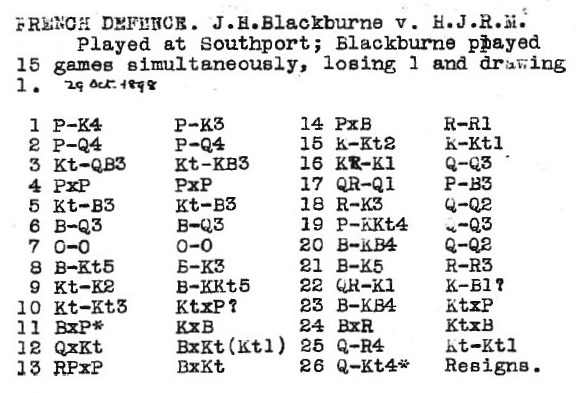
1 e4 e6 2 d4 d5 3 Nc3 Nf6 4 exd5 exd5 5 Nf3 Nc6 6 Bd3 Bd6 7 O-O O-O 8 Bg5 Be6 9 Ne2 Bg4 10 Ng3
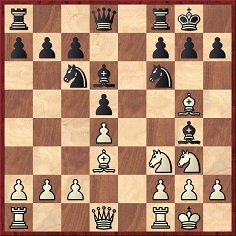
10...Nxd4 11 Bxh7+ Kxh7 12 Qxd4 Bxg3 13 hxg3 Bxf3 14 gxf3 Rh8 15 Kg2 Kg8 16 Rfe1 Qd6 17 Rad1 c6 18 Re3 Qd7 19 g4 Qd6 20 Bf4 Qd7 21 Be5 Rh6 22 Rde1 Kf8 23 Bf4 Nxg4 24 Bxh6 Nxh6 25 Qh4 Ng8 26 Qb4+ Resigns.
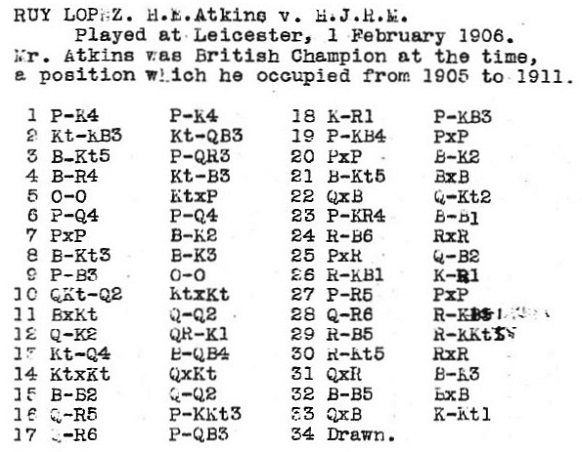
1 e4 e5 2 Nf3 Nc6 3 Bb5 a6 4 Ba4 Nf6 5 O-O Nxe4 6 d4 d5 7 dxe5 Be7 8 Bb3 Be6 9 c3 O-O 10 Nbd2 Nxd2 11 Bxd2 Qd7 12 Qe2 Rae8 13 Nd4 Bc5 14 Nxc6 Qxc6 15 Bc2 Qd7 16 Qh5 g6 17 Qh6 c6 18 Kh1 f6
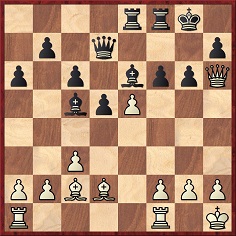
19 f4 fxe5 20 fxe5 Be7 21 Bg5 Bxg5 22 Qxg5 Qg7 23 h4 Bc8 24 Rf6 Rxf6 25 exf6 Qf7 26 Rf1 Kh8 27 h5 gxh5 28 Qh6 Rg8 29 Rf5 Rg4 30 Rg5 Rxg5 31 Qxg5 Be6 32 Bf5 Bxf5 33 Qxf5 Kg8 Drawn.
10875. Chess cartoons
C.N.s 8927, 8943, 9007 and 10427 have reproduced cartoons depicting obsession with chess even when a fire is raging. Further examples:
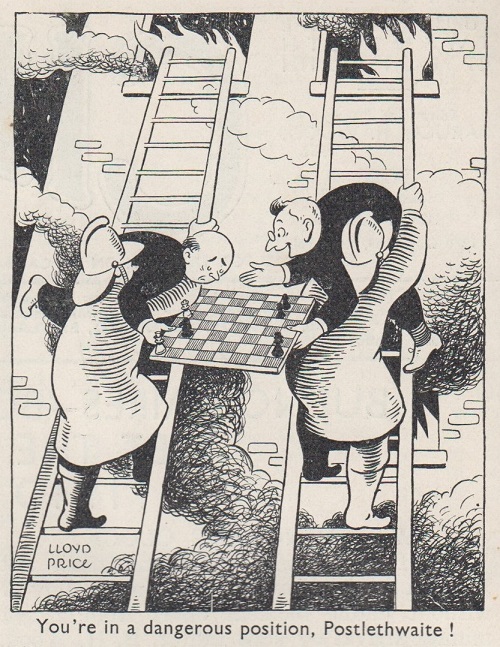
CHESS, 20 August 1939, page 416
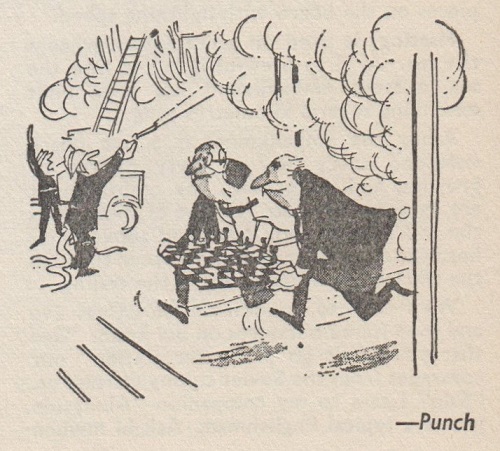
CHESS, 15 December 1962, page 57
See too page 56 of Short v Kasparov The Hi-jacking of The World Chess Championship by William Hartston (London, 1993), page 43 of Square Minded by Saskia de Winter and Willy de Winter (Condesa, 2001) and page 17 of Chess for Laughs by Joel Rothman (London, 2007).
Another illustration of absorption in chess comes from page 84 of Square Minded:
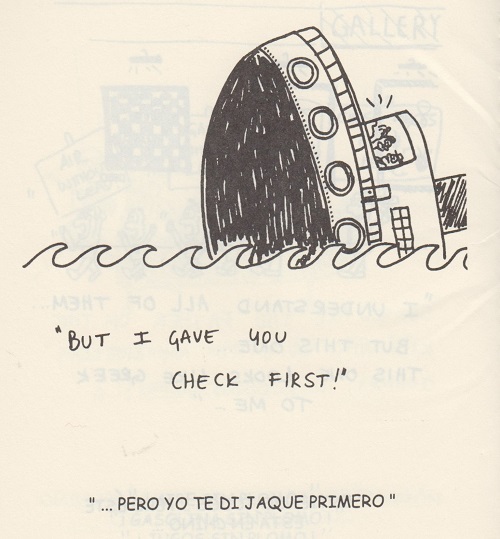
A particularly skilful cartoonist is Jovan Prokopljević. From his 1999 book Chess Miniatures & Caricatures:
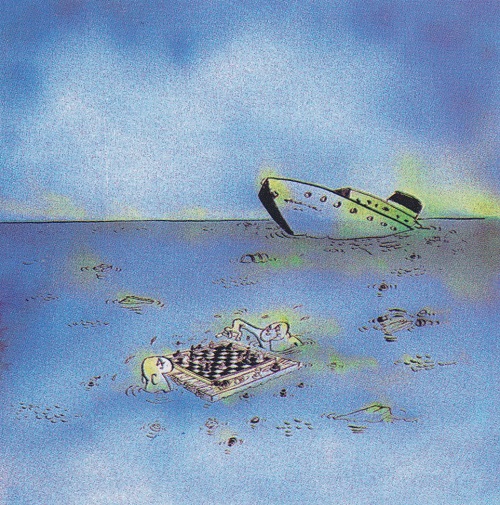
10876. Philidor
Bob Meadley (Narromine, NSW, Australia) has sent us two large files of information on François-André Danican Philidor: part one; part two.
10877. Zollner games
Page 2 of the Newcastle Courant, 26 November 1898 had a pair of victories by Louis Zollner, against Bird and Blackburne, with the mere information ‘recently contested’:
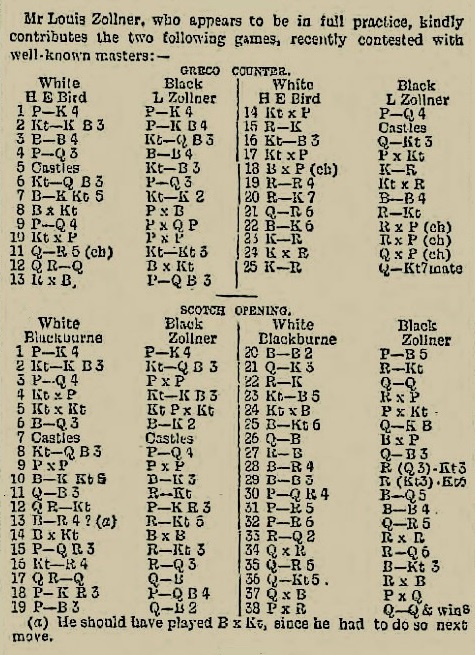
Bird v Zollner: 1 e4 e5 2 Nf3 f5 3 Bc4 Nc6 4 d3 Bc5 5 O-O Nf6 6 Nc3 d6 7 Bg5 Ne7 8 Bxf6 gxf6 9 d4 exd4 10 Nxd4 fxe4 11 Qh5+ Ng6 12 Rad1 Bxd4 13 Rxd4 c6 14 Nxe4 d5
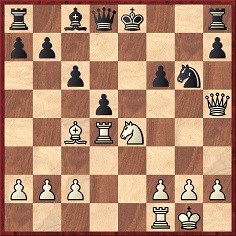
15 Re1 O-O 16 Nc3 Qb6 17 Nxd5 cxd5 18 Bxd5+ Kh8 19 Rh4 Nxh4 20 Re7 Bf5 21 Qh6
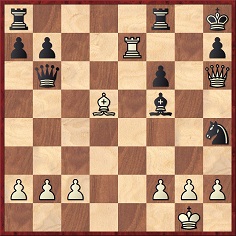
21...Rg8 22 Be6 Rxg2+ 23 Kh1 Rxh2+ 24 Kxh2 Qxf2+ 25 Kh1 Qg2 mate.
Blackburne v Zollner: 1 e4 e5 2 Nf3 Nc6 3 d4 exd4 4 Nxd4 Nf6 5 Nxc6 bxc6 6 Bd3 Be7 7 O-O O-O 8 Nc3 d5 9 exd5 cxd5 10 Bg5 Be6 11 Qf3 Rb8 12 Rab1 h6 13 Bh4 Rb4 14 Bxf6 Bxf6 15 a3 Rb6 16 Na4 Rd6 17 Rbd1 Qc8 18 h3 c5 19 c3 Qc7 20 Bc2 c4 21 Qe3 Rb8 22 Rfe1 Qd8 23 Nc5 Rxb2 24 Nxe6 fxe6 25 Bg6 Qf8 26 Qc1 Bxc3 27 Rf1 Qf6 28 Bh5 Rdb6 29 Bf3
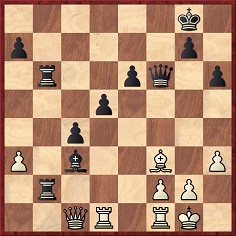
29...R6b3 30 a4 Bd4 31 a5 Bc5 32 a6 Qh4 33 Rd2 Rxd2 34 Qxd2 Rd3 35 Qa5 Bb6 36 Qb5
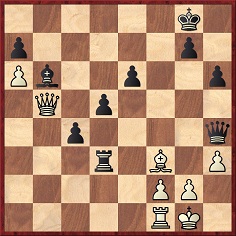
36...Rxf3 37 Qxb6 axb6 38 gxf3 Qd8 39 White resigns.
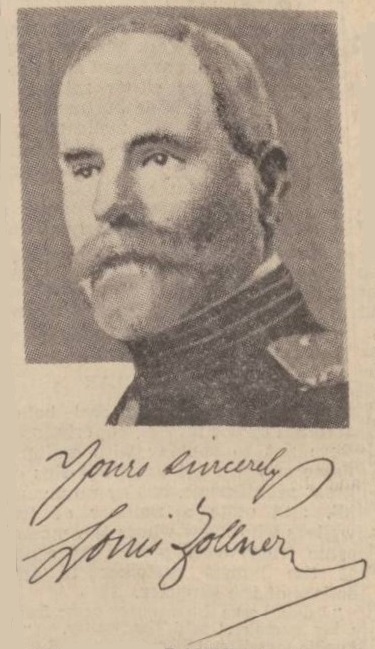
Newcastle Evening Chronicle, 17 April 1939, page 10.
10878. Hitler and Lenin (C.N. 4055)
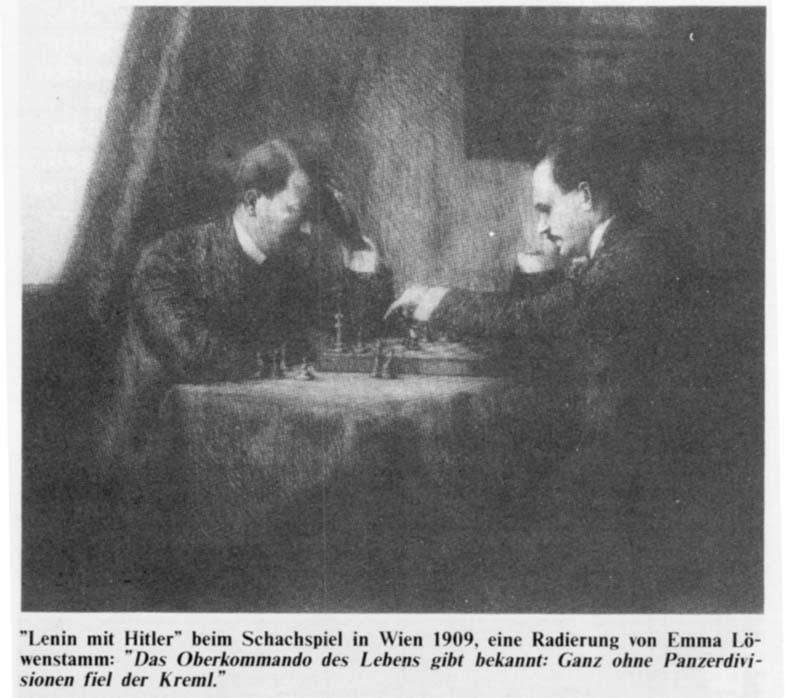
Yury Ryabokon (Moscow), who is a producer with the Russian broadcasting company NTV, asks whether more information is available about this purported picture of Hitler and Lenin (published in the magazine Europa Vorn, spezial Nr. 1/4. Quartal 1991), which a correspondent sent us in 2005.
At that time, the picture became widely known and gave rise to a barrage of speculation, though no facts. Is it possible to do better today?
10879. The Portuguese Opening
From page 2 of the Morning Post, 12 March 1894:
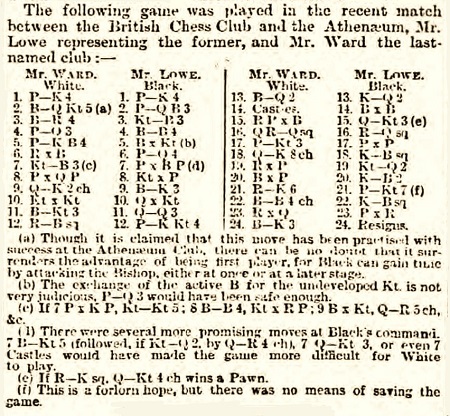
1 e4 e5 2 Bb5 c6 3 Ba4 Nf6 4 d3 Bc5 5 f4 Bxg1 6 Rxg1 d5 7 Nc3 exf4 8 exd5 Nxd5 9 Qe2+ Be6 10 Nxd5 Qxd5 11 Bb3 Qd6 12 Rf1 g5 13 Bd2 Kd7 14 O-O-O Bxb3 15 axb3 Qg6 16 Rde1 Rd8 17 g3 fxg3 18 Qe7+ Kc8 19 Rxf7 Nd7 20 Bxg5 Kc7 21 Re6 g2 22 Bf4+ Kc8 23 Rxg6 hxg6 24 Be3 Resigns.
This game, between W. Ward and H.F. Lowe, was played at the British Chess Club in London on 19 January 1894 (BCM, February 1894, page 57).
The ‘Portuguese Opening’ was discussed briefly in C.N. 2223 (see page 142 of A Chess Omnibus), and the following appeared in the Quotes and Queries column of Chris Ravilious on page 162 of the March 2004 BCM:
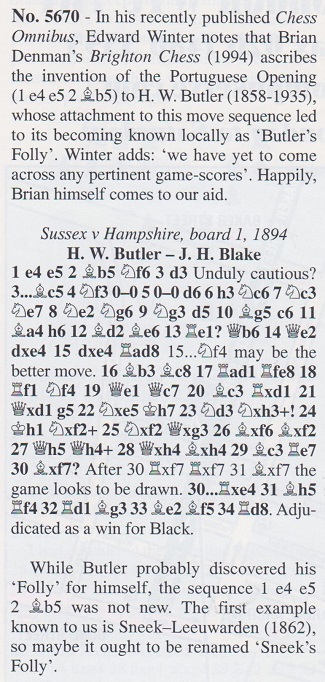
C.N. 2223 mentioned the chapter about this opening on pages 119-124 of No mundo dos Trebelhos by Ronald Câmara (Fortaleza, 1996). From page 119:

How long have the moves 1 e4 e5 2 Bb5 been associated with the name ‘Portuguese Opening’? The reference below, with a mention of ‘the Portuguese Revista de Ajedrez’ [sic], was on page 151 of CHESS, July 1943:

Can a reader send us what appeared in the magazine in question?
From page 240 of the July-August 1910 Wiener Schachzeitung:
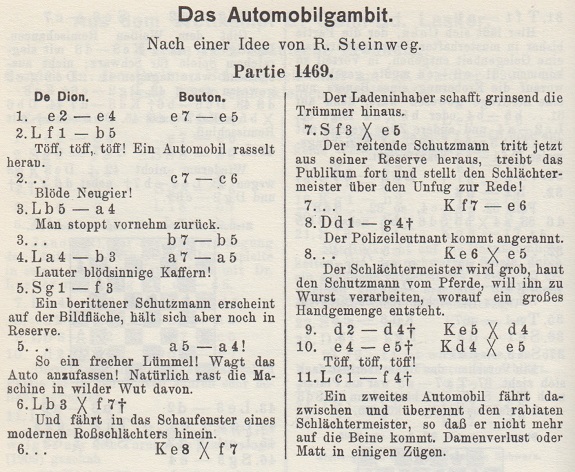
The feature was also published, with minor changes, on pages 59-60 of Deutsche Schachblätter, 15 February 1938:
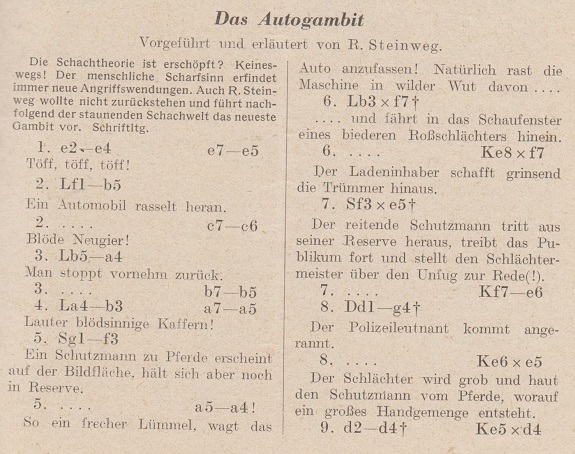

1 e4 e5 2 Bb5 c6 3 Ba4 b5 4 Bb3 a5 5 Nf3 a4 6 Bxf7+ Kxf7 7 Nxe5+ Ke6 8 Qg4+ Kxe5 9 d4+ Kxd4 10 e5+ Kxe5 11 Bf4+.
10880. The quality of justice
‘... the quality of justice, much admired by youth, is inherent in chess.’
That remark by Alan Truscott was quoted on page 210 of CHESS, 20 April 1963:
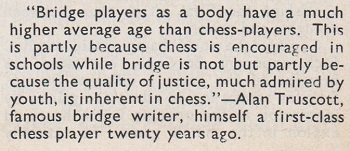
Can the source be traced?
As mentioned in Chess and Bridge, Alan Truscott (1925-2005) wrote the Foreword to Brains in Bridge by Gerald Abrahams (London, 1962 and New York, 1964). Three chess games won by Truscott were given in C.N. 3280 (see pages 131-132 of Chess Facts and Fables).
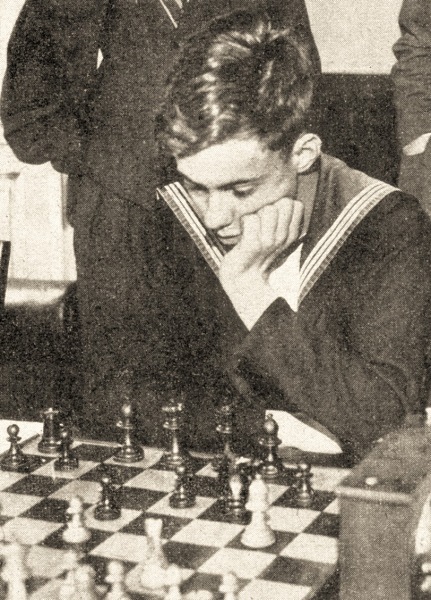
Alan Truscott (CHESS, December 1945, page 55)
10881. Chess and bridge
The feature article mentioned in the previous item also noted Abrahams’ reference on page xi of Brains in Bridge to another expert on both games, Victor Lionel Wahltuch.
On pages 62-63 of the March 1945 BCM Wahltuch wrote an obituary of Louis Zollner which related an episode involving James Mason:

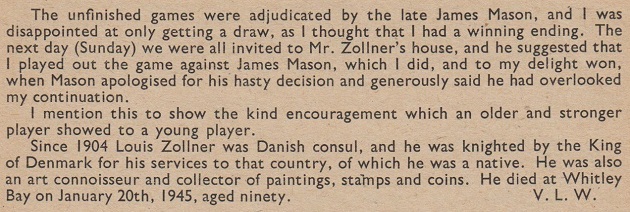
We have not yet found information about the Newcastle v Manchester match.
10882. Louis Zollner
From page 21 of the January 1894 BCM, in the section headed ‘Chess Literature’:

A list of the portraits in David Hum’s The Chess Album has been presented by Martin Smith, and we are grateful to the Cleveland Public Library for providing the photograph of Louis Zollner, published in the February 1894 issue:
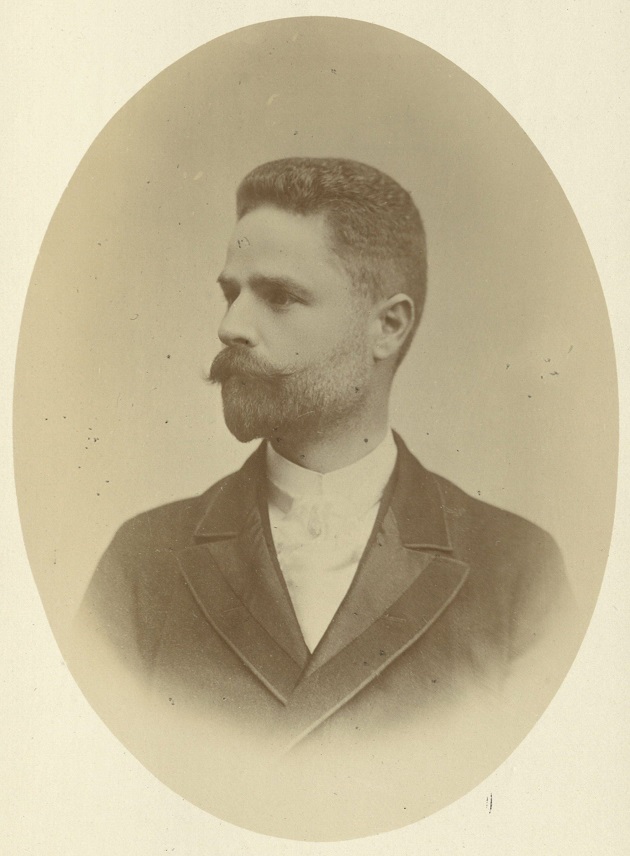
10883. Philip H. Williams
From the source mentioned in the previous item (The Chess Album, August 1894), below, again courtesy of the Cleveland Public Library, is a photograph of Philip H. Williams.
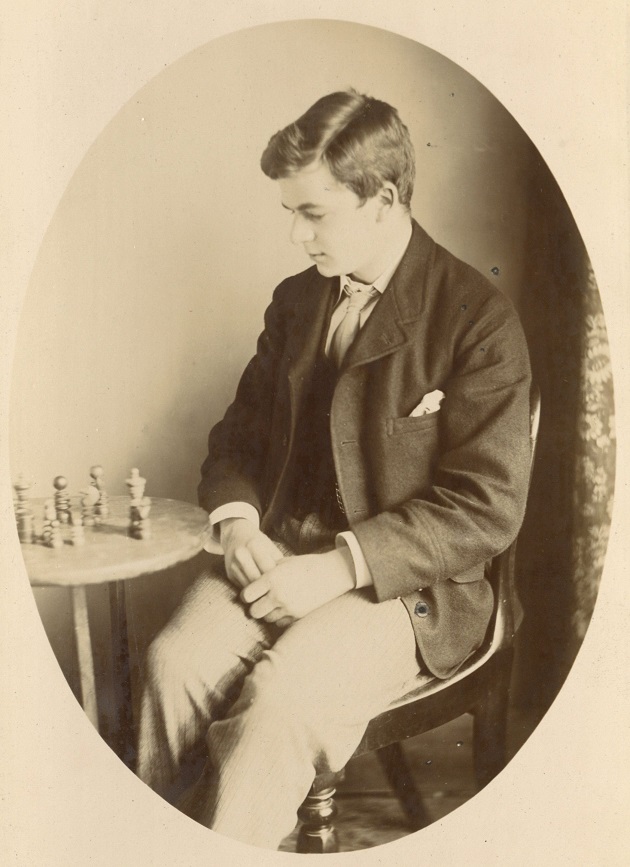
10884. The Hector of Chess
As mentioned at the end of C.N. 10173, the point of nicknames is seldom clear. One that has not caught on is ‘the Hector of Chess’ (Nimzowitsch), which appeared on page 89 of Technique in Chess by Gerald Abrahams (London, 1961):
‘Nimzowitsch reduced Sämisch to Zugzwang in some 22 moves, and Alekhine, playing avenging Achilles, reduced the Hector of Chess to Zugzwang in a game of comparable shortness [at San Remo, 1930].’
10885.
Torre in Boston (C.N. 10829)
Eduardo Bauzá Mercére (New York, NY, USA) sends a
consultation game (John Finan Barry, Weaver Warren Adams
and Sigmund Daniel Putzman v Carlos Torre Repetto, George
Harris Babbitt and C.C. Harvey) played in Boston on 11
January 1925:
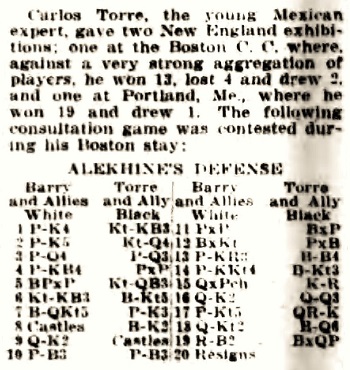
Christian Science Monitor, 20 January 1925, page 16 (column by George H. Babbitt)
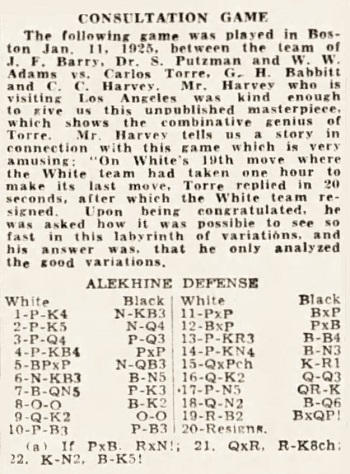
Los Angeles Times, 7 January 1945, page 12 (column by Herman Steiner)
1 e4 Nf6 2 e5 Nd5 3 d4 d6 4 f4 dxe5 5 fxe5 Nc6 6 Nf3 Bg4 7 Bb5 e6 8 O-O Be7 9 Qe2 O-O 10 c3 f6 11 exf6 Bxf6 12 Bxc6 bxc6 13 h3 Bf5 14 g4 Bg6 15 Qxe6+ Kh8 16 Qe2 Qd6 17 g5 Rae8 18 Qg2 Bd3 19 Rf2
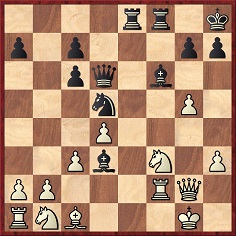
19...Bxd4 20 White resigns.
10886. The Portuguese Opening (C.N. 10879)
Further to the reference by Chris Ravilious to Sneek v Leeuwarden (two cities in the Dutch province of Friesland), the difficulty of establishing a first-hand nineteenth-century source for that game is noted by Frits Fritschy (Marval, France).
In two books focussing on correspondence contests between clubs/cities, Carlo Alberto Pagni gave only a 1991 work as his source for the pair of games (beginning 1 e4 e5 2 Bb5 and 1 e4 e5 2 Bc4) between Sneek and Leeuwarden, which he dated 1865-66: Tweehonderdvijftig jaar correspondentieschaak in Nederland by L.C.M. Diepstraten (Venlo, 1991).
Regarding Pagni’s volumes, the references are page 40 of volume two of Correspondence Chess Matches Between Clubs 1823-1899 (Turin, 1996) and page 122 of Scacchi senza quartiere (Cesena, 2004).
We plan to revert to this topic shortly.
10887. London, 1922
From page 9 of the Rockford Morning Star (Rockford, IL, USA), 3 August 1922, in a feature by Archie Ward:

10888. Nelson v van Lennep
Page 7 of the Norwood News and Crystal Palace Chronicle, 19 February 1898 had this game:
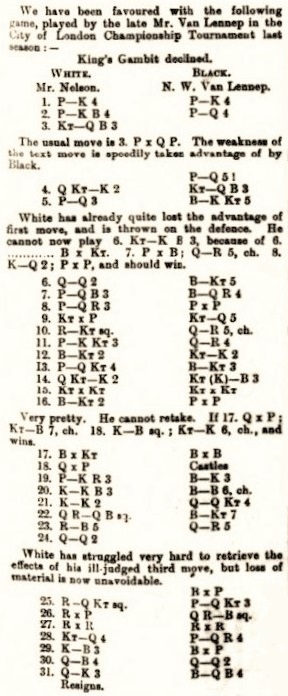
1 e4 e5 2 f4 d5 3 Nc3 d4 4 Nce2 Nc6 5 d3 Bg4 6 Qd2 Bb4 7 c3 Ba5 8 a3 dxc3 9 Nxc3 Nd4 10 Rb1 Qh4+ 11 g3 Qh5 12 Bg2 Ne7 13 b4 Bb6 14 Nce2 Nec6 15 Nxd4 Nxd4 16 Bb2
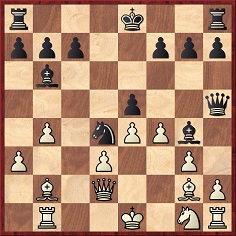
16...exf4 17 Bxd4 Bxd4 18 Qxf4 O-O 19 h3 Be6 20 Nf3 Bc3+ 21 Ke2 Qb5 22 Rbc1 Bb2 23 Rc5 Qa4 24 Qd2 Bxa3 25 Rb1 b6 26 Rxc7 Rac8 27 Rxc8 Rxc8 28 Nd4 a5 29 Kf3 Bxb4 30 Qf4 Qd7 31 Qe3 Bc5 32 White resigns.
10889. Teichmann v N.N.
This game was published on page 7 of the Standard, 3 January 1894:
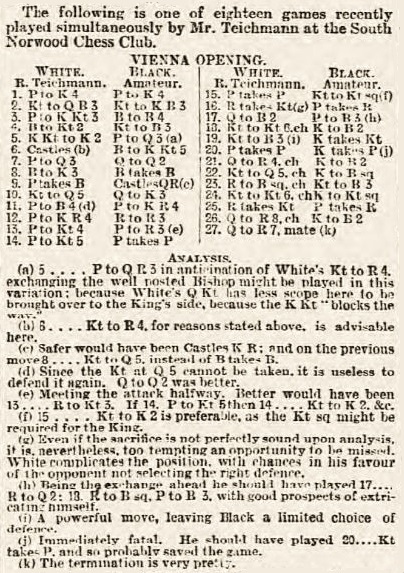
1 e4 e5 2 Nc3 Nc6 3 g3 Bc5 4 Bg2 Nf6 5 Nge2 d6 6 O-O Bg4 7 d3 Qd7 8 Be3 Bxe3 9 fxe3 O-O-O 10 Nd5 Qe6 11 c4 h5 12 h4 Rh6 13 b4 a6 14 b5 axb5 15 cxb5 Nb8
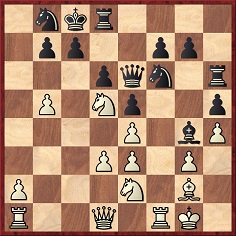
16 Rxf6 gxf6 17 Qc2 c6 18 Nb6+ Kc7 19 Nc3 Kxb6 20 bxc6 Kxc6 21 Qa4+ Kc7 22 Nd5+ Kc8 23 Rc1+ Nc6 24 Nb6+ Kb8
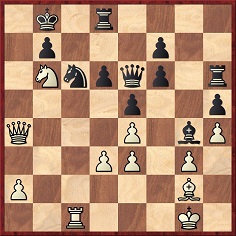
25 Rxc6 bxc6 26 Qa8+ Kc7 27 Qa7 mate.
Page 21 of the January 1894 BCM reported that Teichmann’s display (+15 –1 =2) at the South Norwood Chess Club was on 15 December 1893.
10890. The Irish Gambit
From pages 17-18 of the Columbia Chess Chronicle, 16 July 1887:
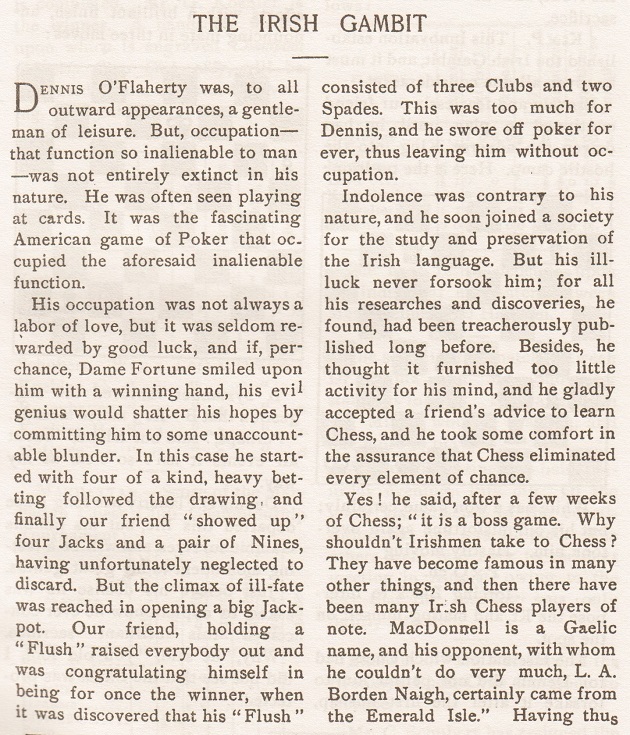
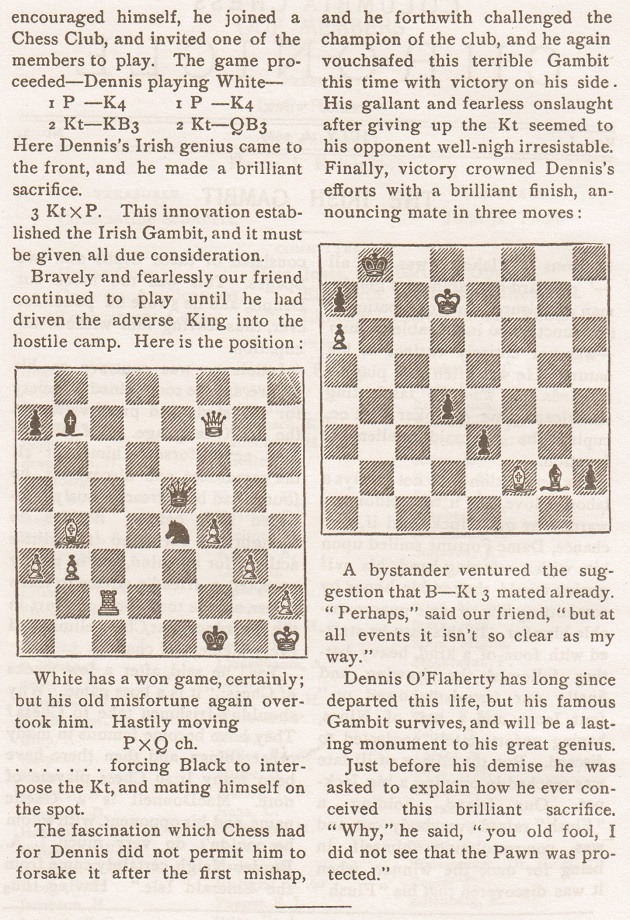
The best-known game beginning 1 e4 e5 2 Nf3 Nc6 3 Nxe5 is D.T. Phillips v H.N. Pillsbury, Chicago, 7 January 1899, published on page 12 of the Brooklyn Daily Eagle, 26 January 1899:
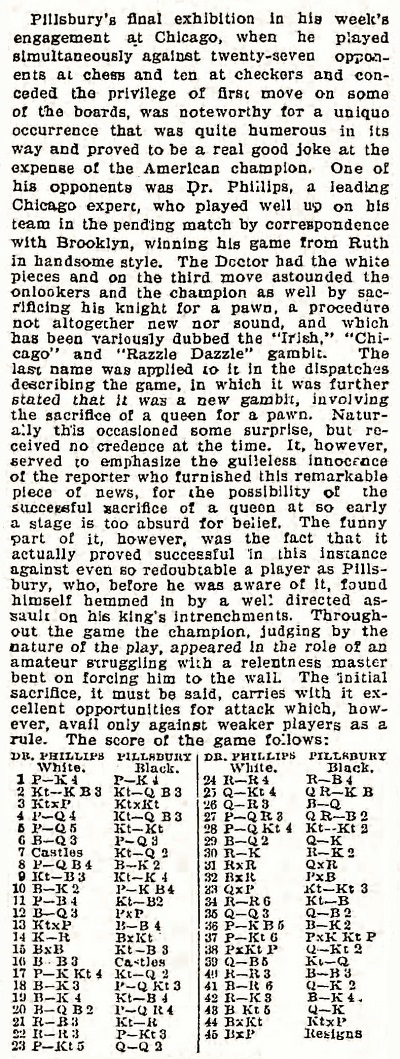
See too page 345 of the American Chess Magazine, February 1899, which was our source in C.N. 1985 (page 69 of Kings, Commoners and Knaves).
10891. ‘The father of modern chess’ (C.N. 8687)
A Field article reproduced on pages 171-172 of the March 1915 Chess Amateur began:
‘The father of modern chess was the great player and writer on the game, the Frenchman Philidor.’
Pages 200-201 of the April 1915 Chess Amateur had a lengthy response to the article from B. Goulding Brown. One of his conclusions:
‘Lewis, not Philidor, was the “father of modern chess”.’
10892. California photographs
Olimpiu G. Urcan (Singapore) draws attention to a number of items in the Los Angeles Times Photographic Archive (Department of Special Collections, Charles E. Young Research Library, UCLA) and other material available via the UCLA Library Digital Archives:
- A 1926 picture of Lasker in Los Angeles;
- A 1932 original drawing of Alekhine in Pasadena;
- A 1932 photograph of Alekhine, Dake, Reshevsky and Kashdan in Pasadena;
- Shots of Charles Boyer and Herman Pilnik playing chess and other pictures of Boyer, Herman Steiner and Humphrey Bogart;
- A 1933 photograph of Herman Steiner and his wife, as well as other photographs of him from the 1930s;
- A 1936 image of Isabel Jewell and Ronald Colman playing chess during the filming of Lost Horizon;
- 1930s shots of Joseph Schildkraut.
10893. Sussex Chess Association
Olimpiu G. Urcan has also provided this group photograph of members of the Sussex Chess Association, which he found in a May 1886 copyright application by the photographer Henry Spink (Records of the Copyright Office of the Stationers’ Company, April-June 1886 folder):
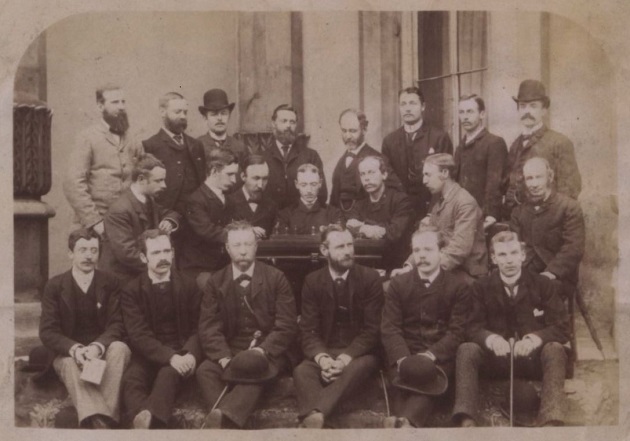
For general guidance, our correspondent has added a list of the top members of the Sussex chess team that year, from page 5 of the Sheffield and Rotherham Independent, 13 March 1886.
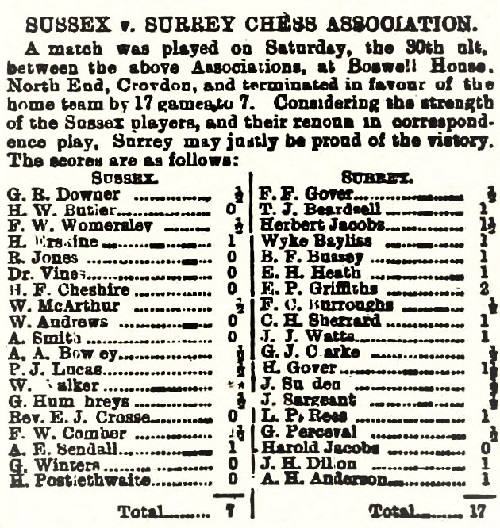
10894. Another Punch cartoon
From page 414 of Punch, 19 September 1962:
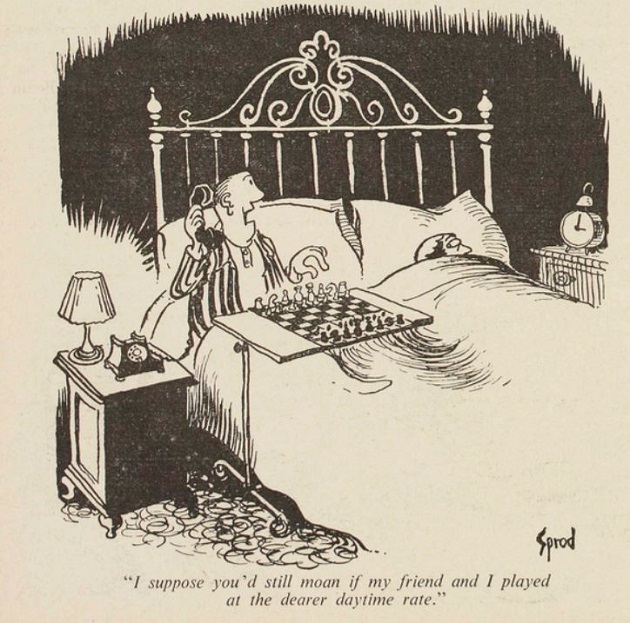
10895. Hieronymus Fischer
A brief obituary of Hieronymus Fischer, a chess composer seldom mentioned nowadays, was published on page 39 of the February 1927 Deutsche Schachzeitung:

A composition of his was shown in C.N. 10693, from page 42 of Terms and Themes of Chess Problems by S.S. Blackburne (London, 1907). Another was on page 141, but in neither case was Fischer named. Only the title of his book was given – misspelt as ‘Humor in Schach’ and ‘Humour in Schach’.
Humor im Schach was published in Potsdam in 1904-05 and was scrutinized in some detail in the Wiener Schachzeitung, July-August 1905, pages 216-220, and, by B.G. Laws, in the BCM (June 1905, page 248, and July 1905, pages 286-288). Both above-mentioned compositions were shown by Laws, whose view of Humor im Schach was mixed. Among his comments:
‘The bulk of the compositions presented are sui-mates, but these are mostly designed to illustrate fancies, and in this endeavour the author has given proof of an intelligent perception of the art itself, and his parodies or burlesques of the works of several composers are alike clever and amusing. There are a few ordinary mates, but these are not heavily charged with profundity or complexity.’
Michael McDowell (Westcliff-on-Sea, England) has sent us a selection of problems from the book, and we begin with the two compositions already referred to, ‘Die Jagd’ and ‘Der intelligente Bauer’:
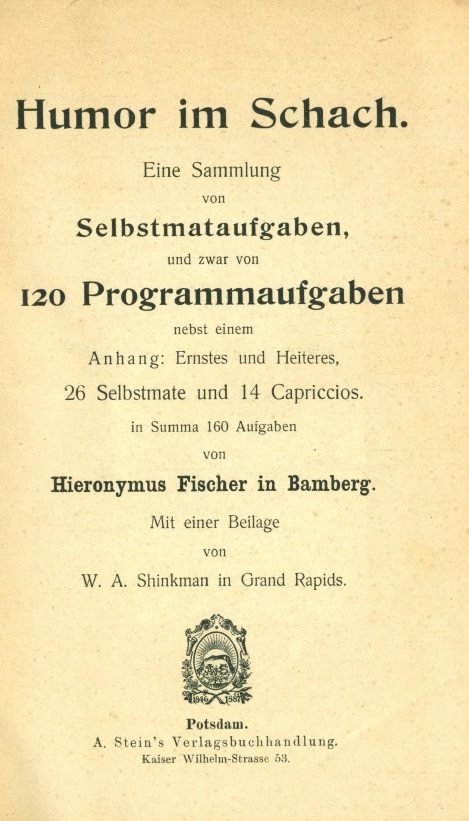
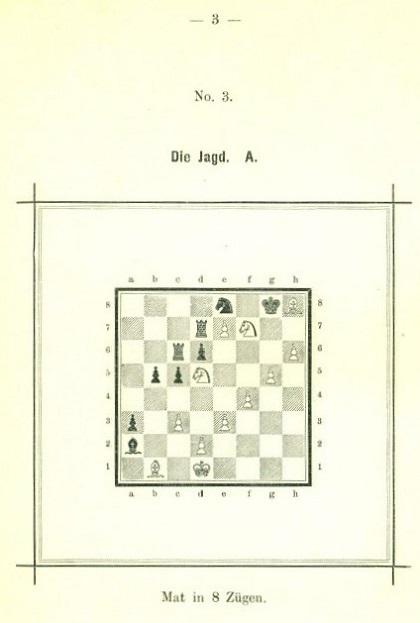
This is the problem in C.N. 10693. In the BCM Laws gave it incorrectly with a black pawn on e7 and wrote: ‘This reminds one of an old sui-mate by Herren Kohtz and Kockelkorn.’ Michael McDowell notes the following composition on page 251 of the August 1866 Deutsche Schachzeitung:
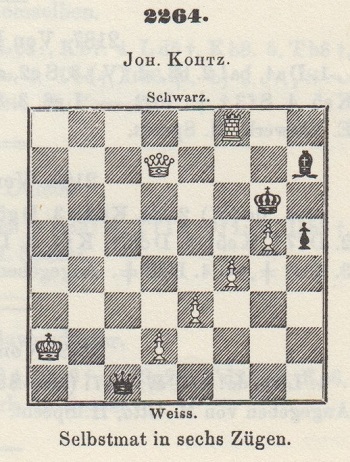
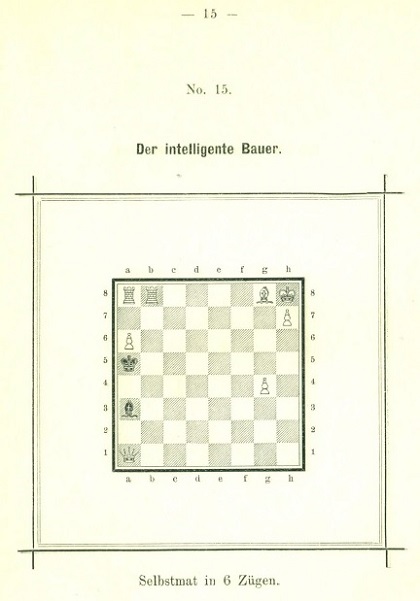
Some more problems in Fischer’s book which have been selected by our correspondent:
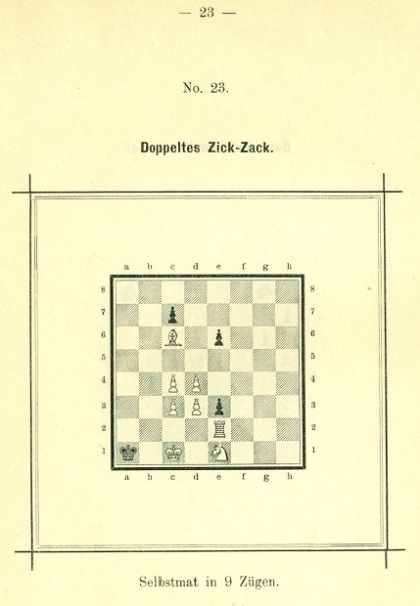
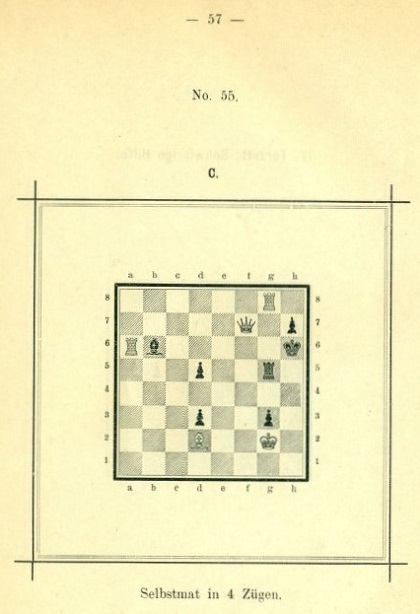
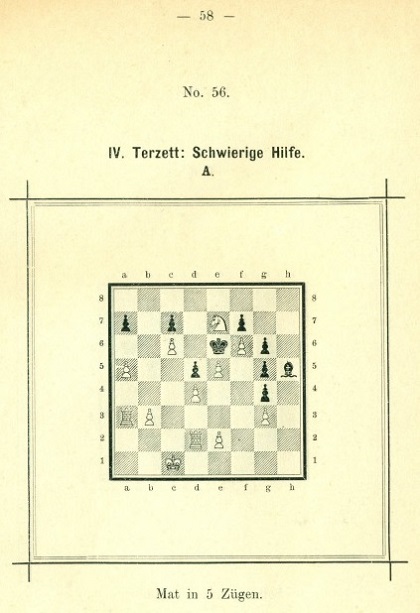
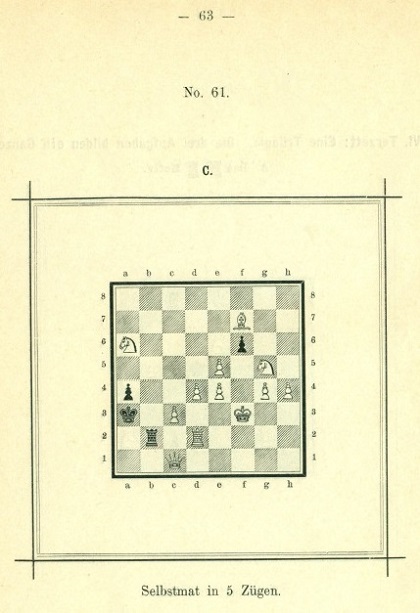
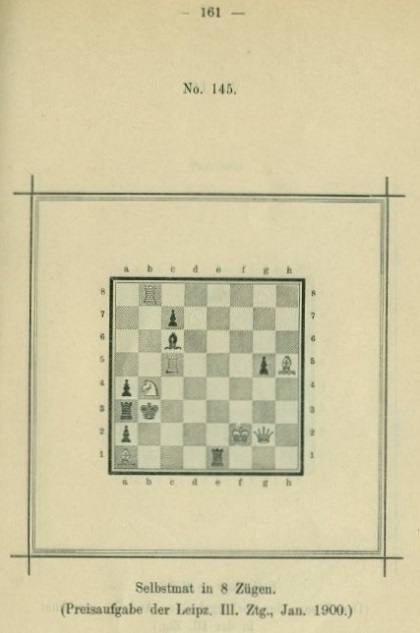
Mr McDowell adds that the last two compositions above were among five by Fischer in Friedrich Chlubna’s 1998 book Versunkene Schätze, a collection of problems from the period 1891-1913 which were considered to be of high quality but little known.
10896. The Chess Album (C.N.s 10882 & 10883)
Courtesy of the Cleveland Public Library, seven more photographs are shown from The Chess Album by David Hum (London, 1893-94):
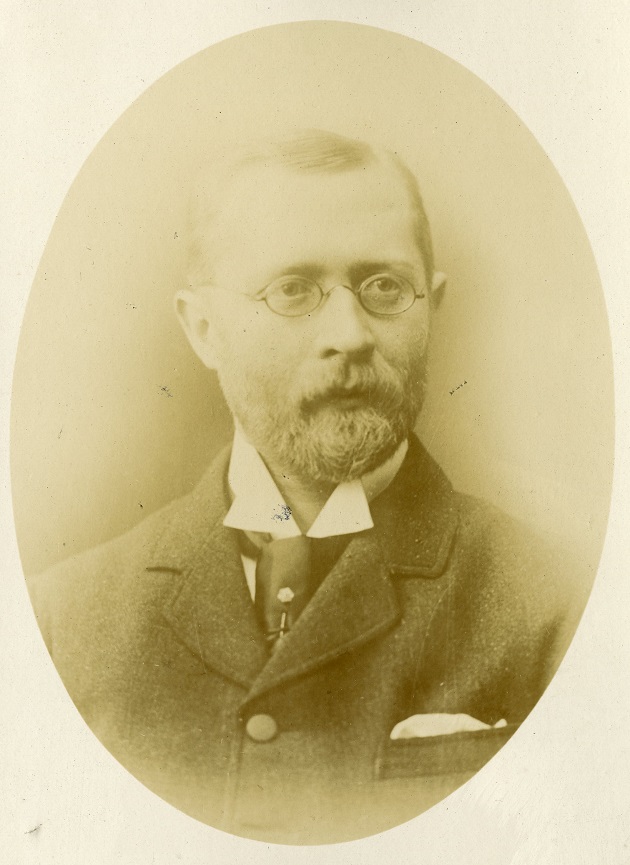
Isaac McIntyre Brown
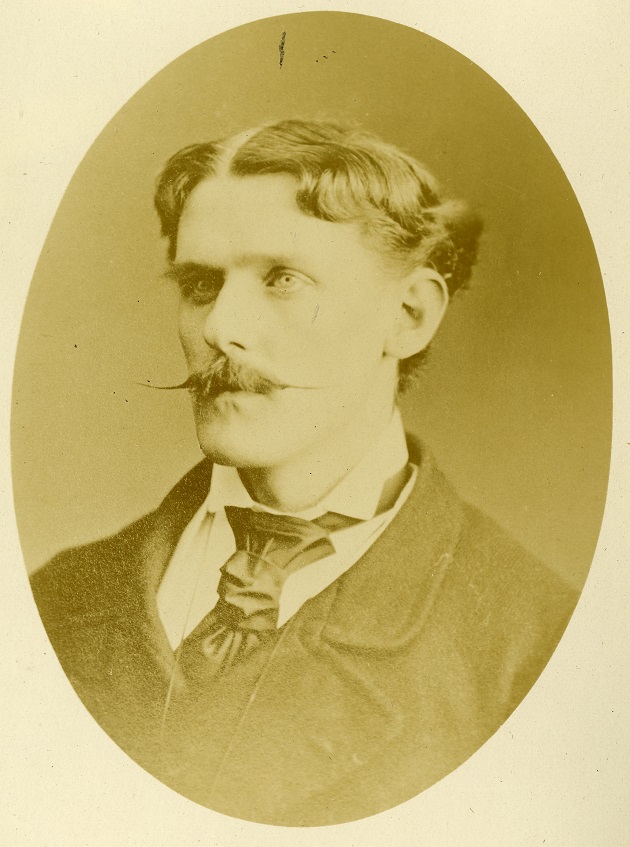
Wordsworth Donisthorpe
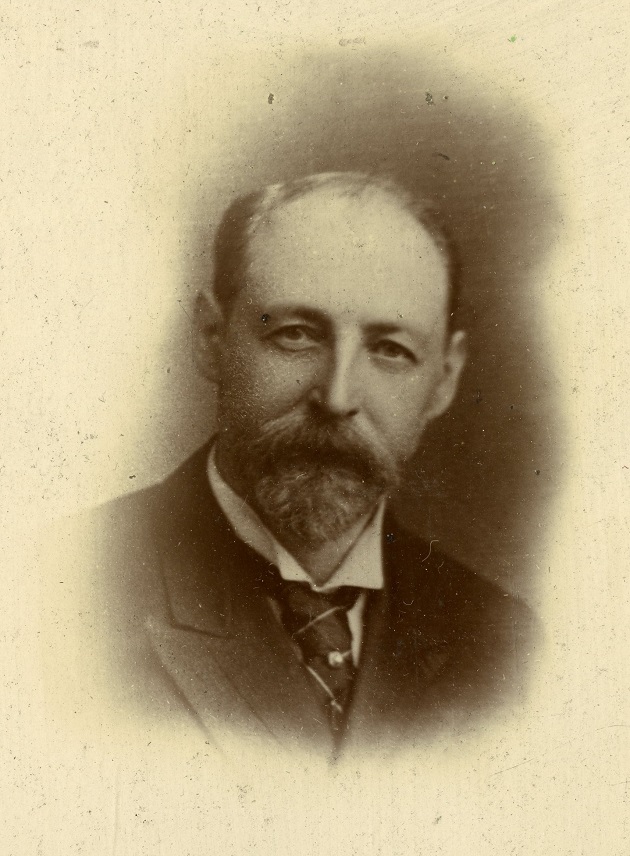
Edward Nathan Frankenstein
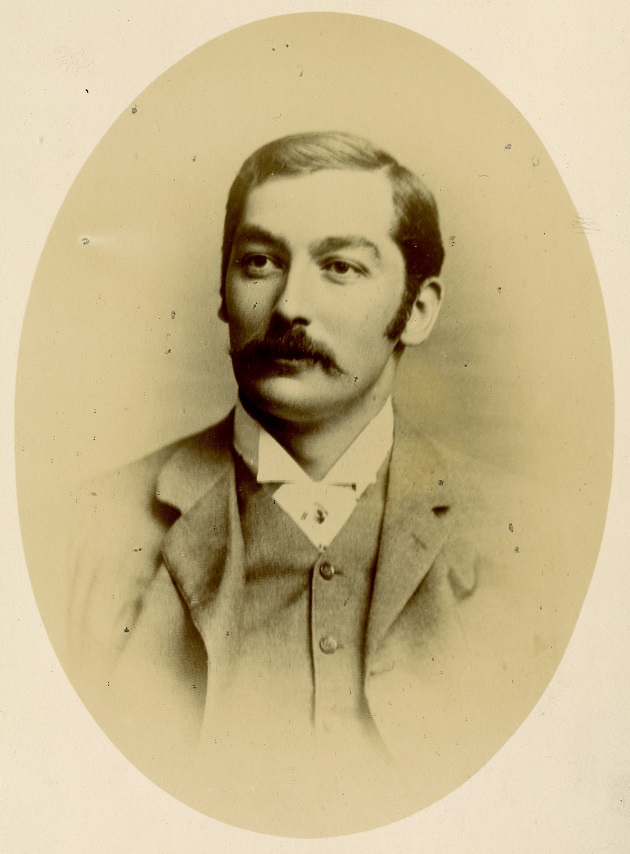
Antony Guest
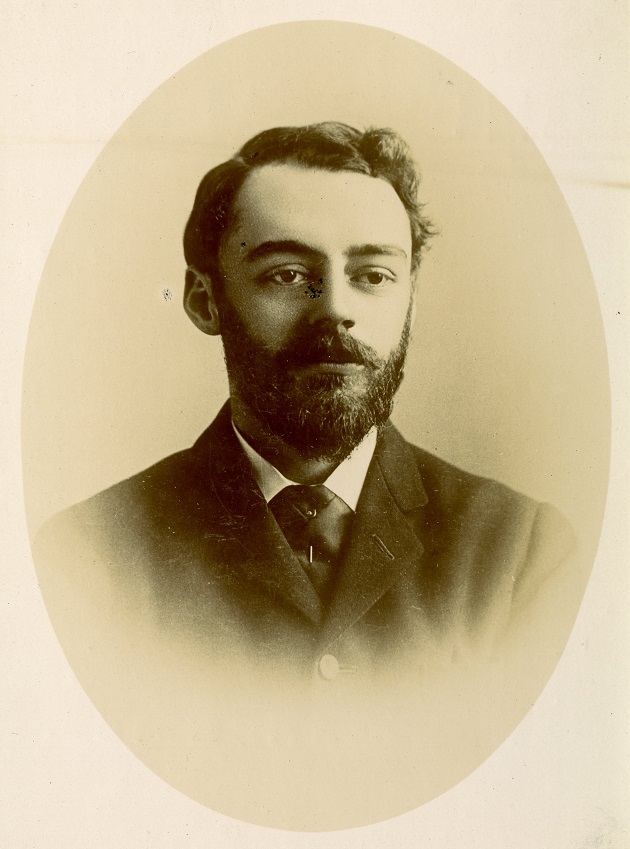
Godfrey Heathcote
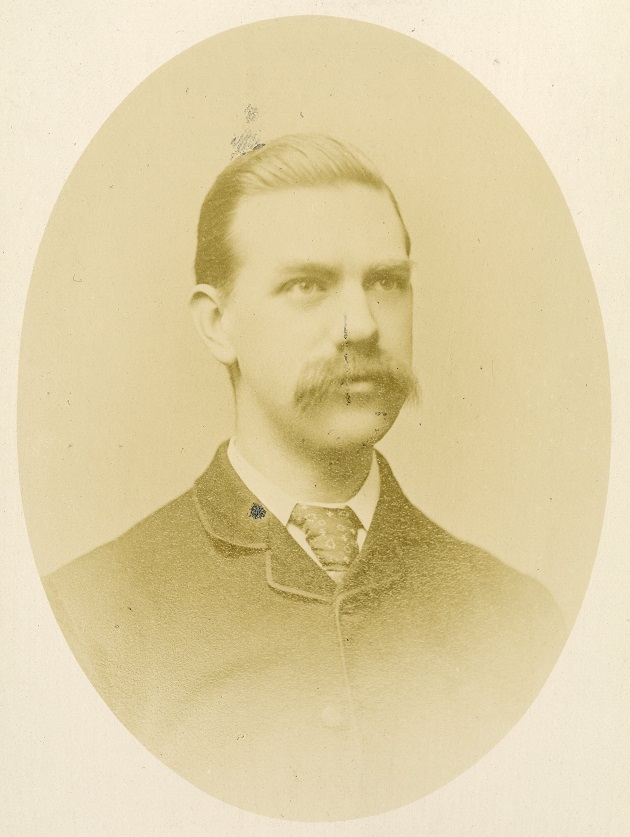
Leonard Percy Rees
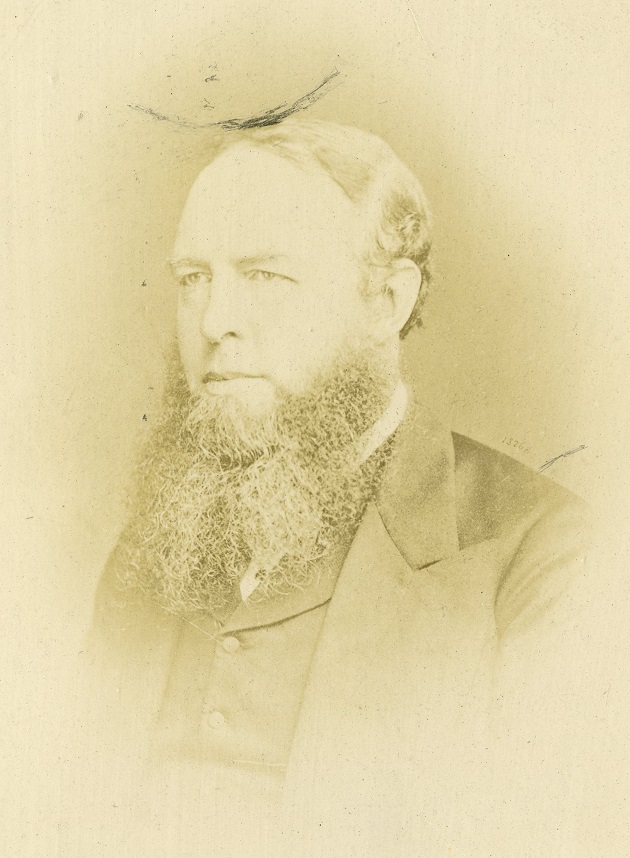
William Wayte
10897. The Portuguese Opening (C.N.s 10879 & 10897)
The Cleveland Public Library has also sent us page 180 of Het schaakspel in Nederland by Antonius van der Linde (Utrecht, 1875):
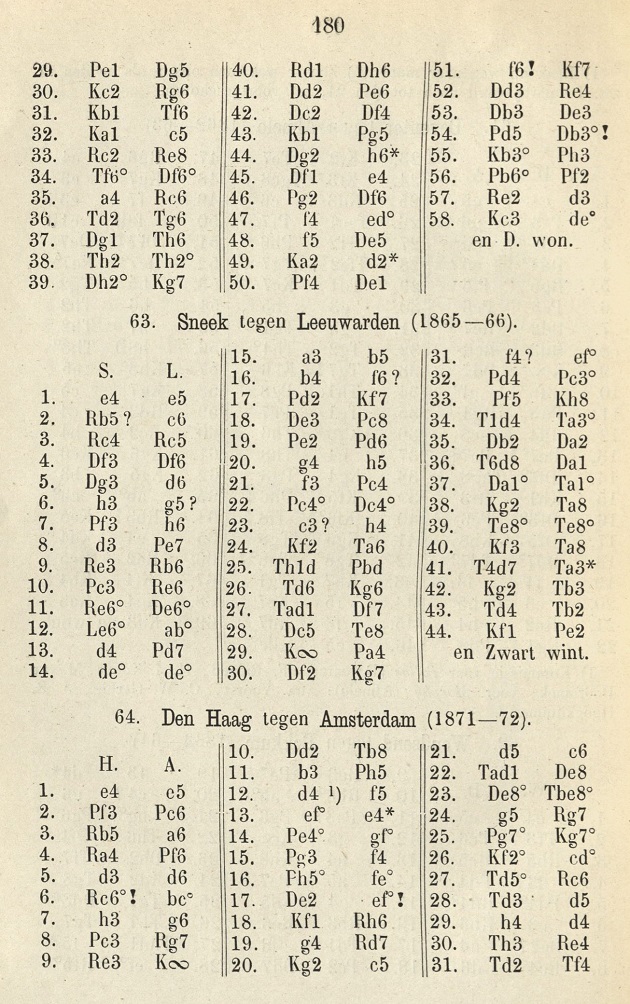
10898. An important figure
An important chess figure less familiar than he should be:
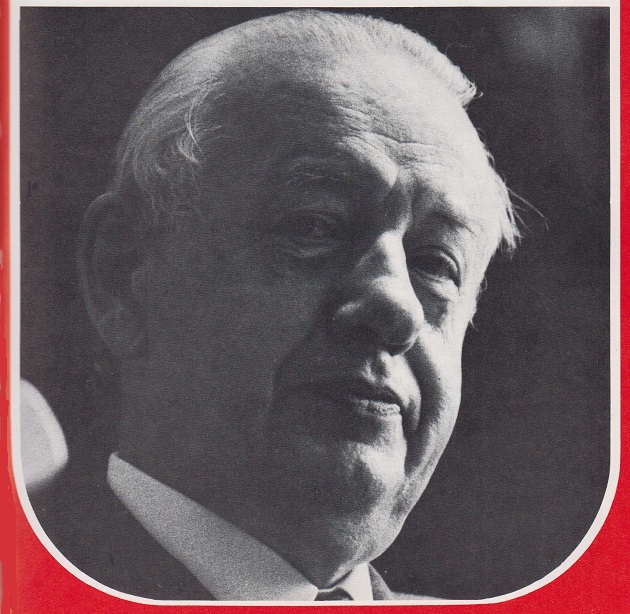
| First column | << previous | Archives [167] | next >> | Current column |
Copyright: Edward Winter. All rights reserved.